Cornell Report
The Hilltop’s Hidden Spaces

No. 3 Volume 45 / SUMMER 2022
 ON THE COVER: Foxden Press, named after the Van Etten-Lacey House’s nickname, prints cards, broadsides, chapbooks, artist’s books, and other materials using the Washington Letterpress with ink and metal type.
PHOTO BY MEGAN AMR
College Archivist Meghan Yamanishi keeps this hidden space’s items organized and preserved, including this turn of the century stereoscope.
ON THE COVER: Foxden Press, named after the Van Etten-Lacey House’s nickname, prints cards, broadsides, chapbooks, artist’s books, and other materials using the Washington Letterpress with ink and metal type.
PHOTO BY MEGAN AMR
College Archivist Meghan Yamanishi keeps this hidden space’s items organized and preserved, including this turn of the century stereoscope.
MEGAN AMR





44 Alumni News 54 In Memoriam 56 Last Word Around the Hilltop D E P A R T M E N T S CONTENTS L I F E A F T E R CO R N E L L Trang
Economist keeping connections 26 Kathie
Finding joy in giving back 14 Shawn
Empowering tech access for all 18 1 CORNELL REPORT | SUMMER 2022 All-Americans continue their winning ways 19 27 The Hilltop’s hidden spaces
Hoang ’15
Adams Meyer ’67
Henning ’96
You Said
Cornell Report
EDITOR
Dee Ann Rexroat ’82
drexroat@cornellcollege.edu
319.895.4241
ASSISTANT EDITOR
Lisa Gray Giurato
DESIGN
Amy Belice Graphic Design
PRINTER
Lane Press
CLASS NEWS CONTRIBUTORS Maxwell Love Joshua Waldorf
Cornell
RESPONDING TO ADVICE FOR CORNELL GRADS

Janessa Weightman ’15
No one else seems to move at the same pace. 3.5 weeks is not enough time for most people!
RESPONDING TO CORNELL LEGACY FAMILIES
Lisa Convey Hancox ’92
Both my husband (1989) and I (1992) attended Cornell, and we now have a daughter there who will graduate in 2023, as well as a future freshman to start next year (2026).
June Marie Crow Schrader ’93
Contact Us
GIFTS TO CORNELL
ADDRESS CHANGE
877.MVERNON (683.7666) giving@cornellcollege.edu
ALUMNI ENGAGEMENT OFFICE
319.895.4204 alumni@cornellcollege.edu
REGISTRAR
319.895.4372 registrar@cornellcollege.edu
ATHLETICS
319.895.4230 athletics@cornellcollege.edu
ADMISSION
800.747.1112 admission@cornellcollege.edu
cornellcollege.edu/cornell-report
Said on campus
ONLINE-ONLY OPTION
To opt out of the printed magazine and be notified by email when each issue is online, contact the editor at cornellreport@cornellcollege.edu
My son is graduating this year and I graduated in 1993. And Rev. Thomas married my husband and me at Palisades in 1996.
Michelle Montgomery Gardes ’95
My daughter Audrey is about to complete her first year at Cornell. Both my husband and I are 1995 alums.
RESPONDING TO A POST ON OLIN HALL
Mandy Beth Landuyt ’99
Proud to be one of the first females to live in Olin its first coed year in 1996-97.
William L. Keyser ’82
Oh, it was definitely and unofficially coed in the ’70s.
Dave Edwards ’87 And likely every decade. lol
Marta Wherry Mathatas ’74
I lived in Olin for a week during the great dorm switch of 1972-73, when we ‘demonstrated’ for co-ed dorms.
BE PART OF THE CONVERSATION
KUDOS TO KAHL
Kerry Kahl (spring 2022 issue) deserves all the kudos that are being sent his way. He has raised the level of sports information directorship to new heights and is more than receptive to any request that comes his way. We are fortunate to have him serving the Cornell sports community.
Tom Cox ’52
Lake Forest, Illinois
‘I SEE YOU’ WINS 2 INTERNATIONAL DEI AWARDS
“I See You,” the summer 2021 Cornell Report guest-edited by Heather ‘Byrd’ Roberts ’09, won two international awards for Diversity, Equity, and Inclusion (DEI).
It is a silver winner in the DEI category of the inaugural Anthem Awards, which received nearly 2,500 entries from 36 countries. The Anthem Awards was launched to amplify voices that spark global change.
It is also an Award of Distinction (silver) award winner in the DEI category for the Communicator Award, selected by the Academy of Interactive and Visual Arts from among 4,000 entries.
We are delighted to publish letters and social media mentions. Tag @cornellcollege to be considered on social media. Send letters to cornellreport@cornellcollege.edu or Cornell Report, Box 1648, 600 First St. SW, Mount Vernon, IA 52314-1098. Submissions are edited for style, length, and clarity.


Report is published fall, spring, and summer for alumni, parents, faculty, staff, and friends of the college by the Office of Marketing and Communications, Box 1648, Cornell College, 600 First Street SW, Mount Vernon, IA 52314-1098
Volume
2022
45 / SUMMER
3
No.
“... through these four years of historical events, Cornell has continued to feel like a home. This is because of the people.”
Lauren Williams ’22 Student Commencement speaker and the 2022 Young Trustee
Lauren Williams ’22 shakes hands with President Jonathan Brand after her name is read at Commencement.
ALLAN RECALDE 2
Around the Hilltop
After the Cornell Report ran a story on Charles Thomas Hayes ’77, Assistant Professor of Music Christopher Nakielski invited him for a residency. Hayes was on campus for a week in February, culminating with a concert that was a high point of the year for many. Cornell’s choirs performed Robert Ray’s “The Gospel Mass” under Hayes, and Hayes and his Chicago area musician friends showcased African American music.

3
MEGAN AMR
The SAW set to open Aug. 9
The renewed and expanded Richard and Norma Small Athletic and Wellness Center (the SAW) is set to open Aug. 9, offering a new level of support for our student-athletes and a new era of fitness and wellness opportunities for the entire community.
Forty-one percent of students now compete on Cornell’s 19 NCAA Division III teams (soon to be 20 with the addition of women’s wrestling). The goal is for all students and the entire campus, including faculty and staff, to feel welcome in the facility.
“The ability to better integrate campus wellness and athletics within the renovated space is an essential feature for the new SAW,” says Associate Professor of Kinesiology and Faculty Athletic Representative Kristi Meyer ’01 . “We hope all students feel welcome in the space, and we are excited to make this the new central hub for campus wellness.”
Many, many donors have teamed with Cornell to support the $19.5 million project. The most recent six-figure gifts from these generous alumni and friends of the college are:
• Douglas Swanson ’60 and Suzanne Swanson: $508,000
• Douglas Smith ’73 : $150,000
• John Turner ’94 and Ann Loewe Turner ’94 : $150,000
• Andrew Applebee ’71 and Julie Applebee: $100,000
• Nels Lindquist ’71 and Cindy Ransom Lindquist ’71 : $100,000
• John Lohnes ’77 : $100,000
• James Swift ’76 and Lori Swift: $100,000
• Georgia Yanicke ’67 : $100,000
NEW ENDOWED FUNDS
Jane Wylie established a $100,000 Neil and Jane Wylie Endowed Scholarship Fund in honor of her husband Neil, who taught psychology at Cornell from 1966 to 1981. Because the Wylies so enjoyed the Cornell experience provided to them and the students of the 1970s, the fund is designed to support similar opportunities for students of today and in the future. Neil died in 2021 (see obit on page 55), and through this scholarship fund, Jane intends for his commitment to higher education and Cornell to continue.
Robert Wilson ’75 and Sara Even Wilson ’76 have pledged $110,000 for a combination of support to the Athletic Facilities Project, the Cornell Fund, and the Paul Even and Bea Even Stuart Endowed Scholarship. That scholarship for first-generation students was established by the Wilsons and Sara’s siblings Susan Even ’74 and her husband Steve Zweig, and Nick Even ’84
4
Fulbright Award sends Stolz to Bulgaria
In her first semester on campus, Tessa Stolz ’22 created a four-year plan with Writing Studio Director and Director of Fellowships and Scholarships Laura Farmer. While the plan changed, Farmer’s support and encouragement were steady.

So when Stolz received a coveted Fulbright award, Farmer was one of the first to find out.
“We were able to scream in excitement and reflect on my past four years at Cornell, with only a few tears shed,” Stolz says.
Stolz, who is from Lincoln, Nebraska, will be going to Bulgaria for a Fulbright English Teaching Assistant (ETA) Award. She will teach English to high school students and spend time on community engagement. She majored
in anthropology and psychology: specialist concentration.
We asked her a few questions before she finished her last block.
What have you learned at Cornell?
There are so many opportunities at Cornell that help us all grow as individuals and as a greater community, and I did not realize how much I have grown as a leader, community member, and overall citizen until I started to reflect on my time here at Cornell.
Describe a benefit of the block plan.
I like the block plan because of the community that is able to be
built and fostered through those 18 days. Being able to easily access your professors for help, being able to rely on classmates for support, and being surrounded by a community are all reasons why I love the block plan.
What is your advice to the classes behind
you?
Do something your senior year that you have not had the time or chance to do yet. Go to that PAAC [Performing Arts and Activities Council] event you have always wanted to go to but never have, join in on an intramural event, and really take in all that Cornell has to offer for your last year.
17 CORNELLIANS WERE AWARDED FULBRIGHTS IN THE PAST 10 YEARS
MEGAN AMR
5 CORNELL REPORT | SUMMER 2022
“We were able to scream in excitement and reflect on my past four years at Cornell, with only a few tears shed.”
Building the Field of Dreams
Kevin Moses ’04 hit a homerun out of the career ballpark when he began work on a baseball field next to the Field of Dreams—a field made famous after the 1989 Kevin Costner movie—in preparation for the first major league baseball (MLB) game in Iowa.
Moses is an account manager for the sports turf division of BrightView Landscapes, MLB’s official field consultant on design, construction, maintenance, and event management for games played outside the 30 league ballparks. Among BrightView’s most recent events, Moses has been part of MLB’s 2018 and 2019 Mexico Series in Monterrey, Mexico, as well as MLB’s 2019 London Series.
As a native Iowan, Moses was happy to work on the Midwest’s version of heaven.
The field in Dyersville hosted the first MLB game in Iowa on Aug. 12, 2021, between the New York Yankees and the Chicago White Sox. It was the most-watched MLB regular-season game in more than a decade. The White Sox defeated the Yankees 9-8.
“You have one chance to pull an event like this off,” Moses said. “One chance to make a good first impression. It was an amazing event, whether you were there in person or

AMY MOSES 6
Elizabeth and Kevin Moses ’04 at the Field of Dreams in Dyersville, Iowa. Moses collects baseball hats (his Field of Dreams hat pictured in the photo) from the ballparks he works on.
AROUND THE HILLTOP
watching on television. It was a really special night, not only for baseball but for the state of Iowa. It took a year to prep it for one event.”
Weather can be the greatest challenge when developing fields or holding events at them. Moses has worked in challenging environments, like the desert in Las Vegas or rainy, humid conditions in Puerto Rico. He says Cornell gave him a background in critical thinking, reading, and writing, which laid a solid educational foundation for his career in sports turf management.
Moses studied history and played baseball for Cornell and has always had a passion for the game, especially the Kansas City Royals. Whenever his family went on a vacation, wherever it was, they made a point of attending a baseball game.
He grew up in Nashua, Iowa, and before school would kick off for the year, his family drove to the Field of Dreams to play catch. The movie was and is his favorite movie.
He never spotted any ghostly players in the cornfields, but he’ll have another chance while working the next game planned for Aug. 11, 2022, between the Chicago Cubs and the Cincinnati Reds.
As president of BACO (Black Awareness Cultural Organization) for two years and chairperson of student life for Student Senate, Cierra Davis ’22 has been deeply involved in the Cornell community. We asked her to reflect on her years on the Hilltop.

What have you learned since your arrival at Cornell?
I learned how to manage my time by handling many projects with my extracurricular activities as well as staying on top of my academics. Balancing a social life as well as academics can be challenging; I have definitely learned how to do so much in so little time.
Who helped you along your college journey?
My academic advisor [Professor of Biology] Craig Tepper has been a father figure to me who has helped me academically, along with steering me in the right direction for my future outside Cornell. Additionally, my boss and Director of Intercultural Life
Hemie Collier has never ceased to give me words of advice when I needed it the most, along with helping me transition into Cornell as an international student.
B.S.S. Environmental Marine Biology
Hometown: NASSAU, BAHAMAS
Next: NOVA SOUTHEASTERN UNIVERSITY TO PURSUE AN M.S. IN MARINE BIOLOGY
What is your advice to the classes behind you?
Always be yourself. Life at Cornell can sometimes be very fast-paced, so staying true to who you are is essential in order to optimize your time. I would say getting involved in student groups gives you a sense of home away from home. College can be tough, but having a support group can make it much smoother. Finally, always put your education first; it is the main reason we all are here, and always do the best that you can. Talk to your advisors, make study groups, and if you can go the extra mile, it all pays off in the end.
“I have definitely learned how to do so much in so little time.”
MEGAN AMR
7 CORNELL REPORT | SUMMER 2022
Ciera L. Davis ’22
Only at Cornell: Canons
King Chapel may be the only chapel in the world built with an armory. That’s right, two canons were stored in the basement and the doorway is still visible from the Pedestrian Mall.
How did we end up with cannons? In 1873 the college gave its male students compulsory military training in response to requests for physical education. The Department of the Army sent an officer from West Point to supervise the training, and he was sent two breech-loading steel cannons. They were left on the lawn next to Old Sem, then a women’s dormitory. At night, a favorite sport was to come out and fire the cannons and the best target was the Mount Vernon waterworks, near where the football field is now. Once the cannons were fired, the explosion broke windows on the west side of Old Sem and frightened its occupants. So in desperation, King Chapel was planned with an armory.
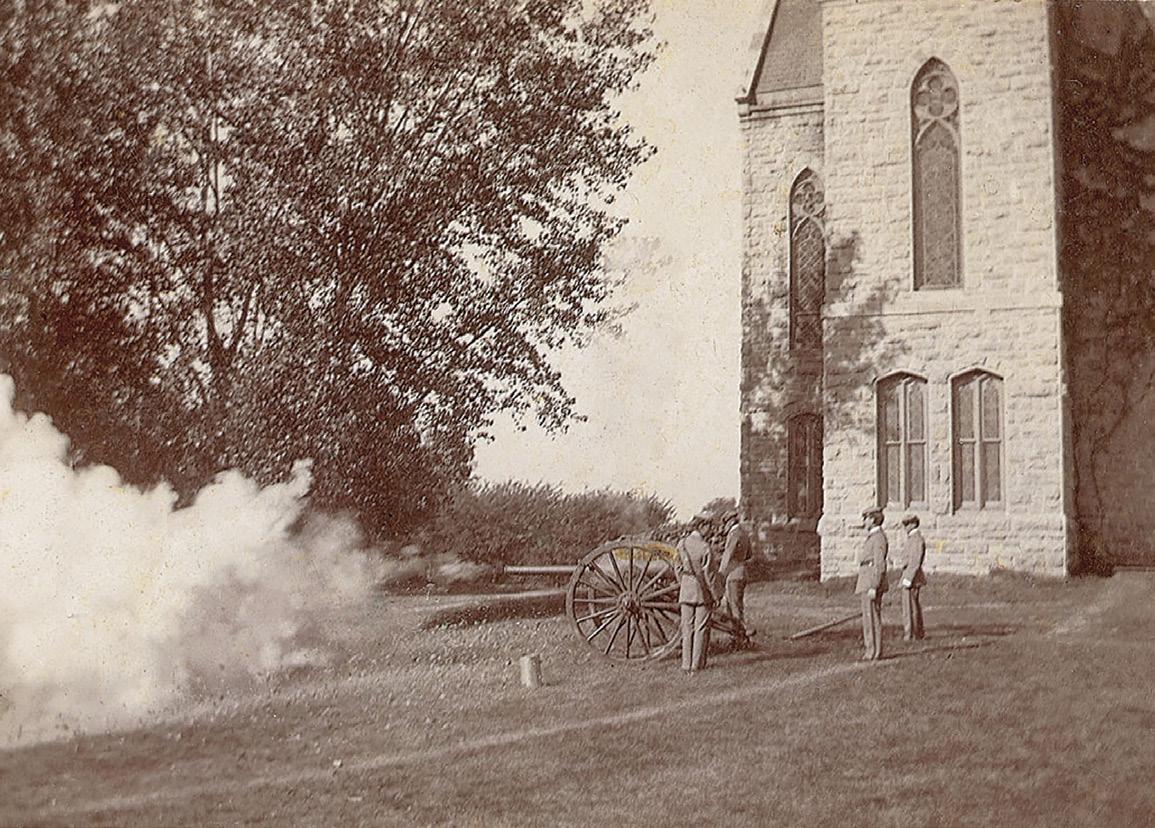
Alas, the Army took the canons back in 1898 when the Spanish American War broke out.

Kinnard ’79, Brown Bomber return to campus
Rupert Kinnard ’79, creator of the oldest continuing Black gay and lesbian comic characters in the U.S., returned to campus in February to exhibit his work where it all began.
Kinnard sketched superheroes as a child and eventually questioned why they were all white. The summer before arriving at Cornell, he started sketching the Brown Bomber, a nonviolent superhero based on boxer Joe Louis (nicknamed the Brown Bomber). When The Cornellian editors learned of his sketchbooks, they asked him to provide editorial cartoons.
“That’s what led the Brown Bomber to being a political character,” Kinnard says. “He was observing antics and things happening on the college campus.”
At the heart of his retrospective, “From Cornell to Cathartica: The History of Cathartic Comics,” were over 15 Brown Bomber comic strips from The Cornellian and cover art from the 1979 Royal Purple.
The Brown Bomber came out as gay in a trilogy of comic strips shortly before Kinnard graduated. More than a parting shot, it was also a beginning for the artist who has made a career of providing social commentary—particularly gay rights and racial justice— through his characters.
After graduating with a degree in art, Kinnard settled in Portland, Oregon. He established the syndicated political comic strip Cathartic Comics, and the Brown Bomber was given a lesbian partner, Diva Touché Flambé (Kinnard has called them “my yin and my yang”). They began appearing in
CORNELL COLLEGE ARCHIVES
8
Just Out, a queer Portland newspaper for which Kinnard was founding art director.
Kinnard didn’t consider himself a pioneer until recognition began flowing to him.
In 1991 his characters were featured in the books “Young, Gay and Proud” and “B.B. and the Diva: A Collection of Cathartic Comics.” In 1996 he received Pride Northwest’s Spirit of
Pride award. In 2007, his business, The Rupe Group Graphics, received the Oregon Cascade AIDS Project Community Angel Award, and in 2013 he received the Standing on the Shoulders Lifetime Achievement Award from the World Arts Foundation. In 2020 Cornell presented him the Distinguished Achievement Award.
And in 2021, along with Alison Bechdel (“Fun
Home”), Kinnard was one of five pioneering cartoonists featured in the documentary “No Straight Lines: The Rise of Queer Comics.”
“I get emotional when I think at the end of all this recognition is a show at Cornell College where it all started,” Kinnard said. “It’s very, very emotional to be invited back to Cornell. I really truly feel like I owe a lot to Cornell for the part it played in the career I have.”
WEB EXTRA
View a video of Kinnard’s gallery talk and a presentation of his Distinguished Achievement Award at crnl.co/kinnard

ENVISAGE STUDIOS
Rupert Kinnard ’79 in Peter Paul Luce Gallery, McWethy Hall, before his artist’s reception.
9 CORNELL REPORT | SUMMER 2022
SEPT. 9–NOV. 16, 2022, PETER PAUL LUCE GALLERY, MCWETHY HALL
OPENING RECEPTION: 3–5 p.m. SEPT. 9
HOMECOMING RECEPTION: 3–5 p.m. OCT. 22
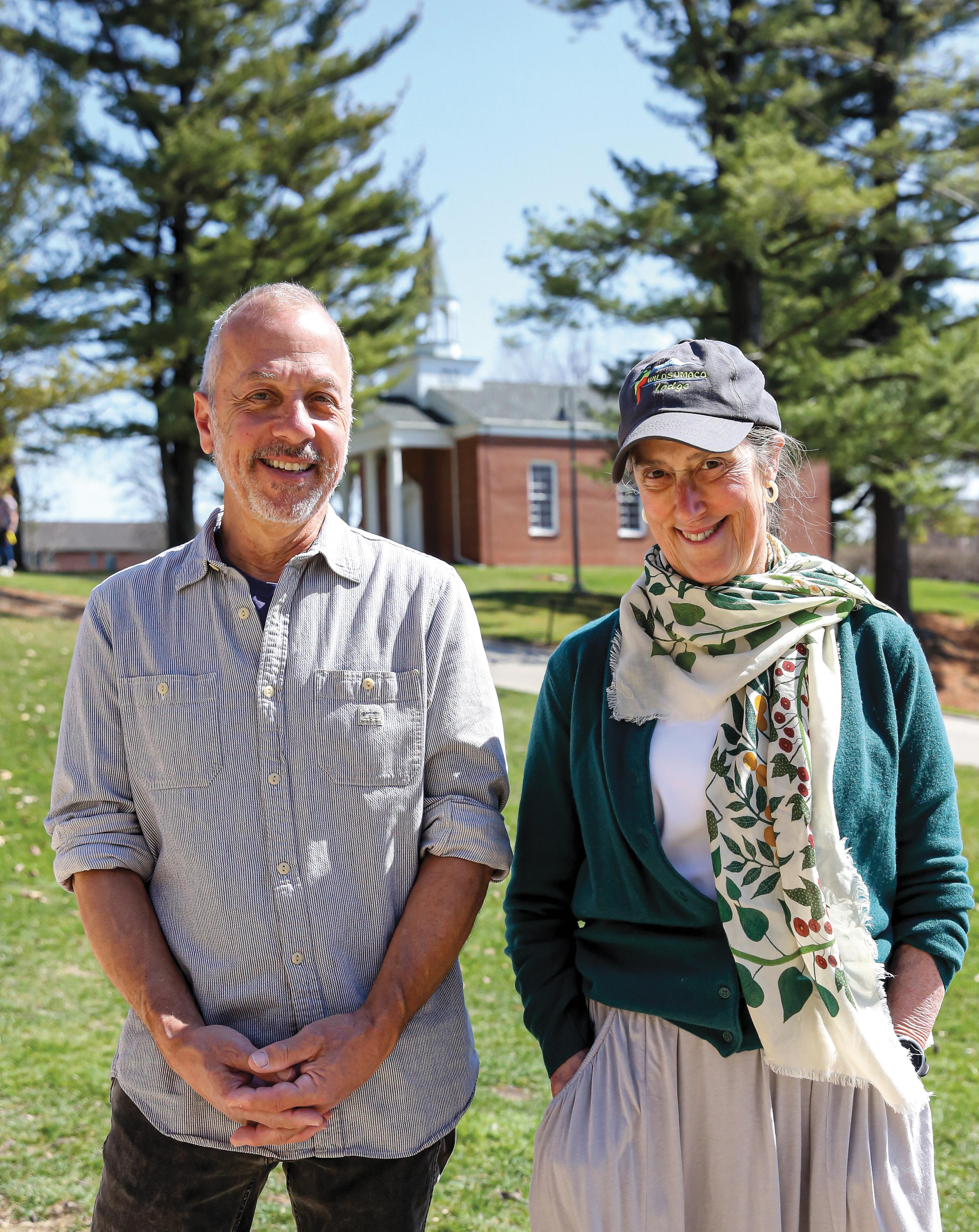
MEGAN AMR
Professors Tony Plaut ’78 and Marty Condon taught Cornell students for a combined 56 years.
“An Array of Wonders: Past, Present, and Future (Tony Plaut Retrospective Exhibition)”
10
Condon, Plaut retire
The art and biology departments are losing two longtime faculty members. We asked them about their Cornell experience and what’s next.
Marty Condon, BIOLOGY, 1996–2022
Favorite course you taught:
Plant Systematics was my favorite course for three reasons: 1) students and I would take daily walks around Mount Vernon and identify as many of the plants as we could; 2) it was fun—we were outside every day and the students learned the names of trees, shrubs, vines, and spring flowers; 3) graduates told me the class had a lasting impact on the quality of their lives.
How did you grow intellectually at Cornell?
Cornell gave me the time to discover amazing patterns of diversity in nature. I had a chance to do science at a rate and rhythm impossible for colleagues at large research universities whose jobs depend on regular publication. The work I do takes time and patience. I study tropical plants and insects that are rare. To find them, we have to plan trips at times when flowering peaks. And that time varies enormously from place to place within Central and South America. The block plan allowed me to travel at any time of the year.
What did you enjoy about Cornell students?
Most Cornell students are genuinely nice people. They are kind and generous. I love doing field work with students who work hard and carefully without complaining. I have especially enjoyed seeing students grow as scientists and as people.
What are your plans?
I plan to continue to do the science I do and to include students who are interested in joining me. I live in Mount Vernon and will continue to be available to sponsor independent studies or research. Thanks to support from Cornell and the National Science Foundation, we have collected many thousands of specimens, sequenced thousands of base pairs of DNA (and RNA), and recorded thousands of hours of video of courtship dances of beautiful tropical flies. Most of the data, which come from work in at least 10 countries, remain to be analyzed. Then our research teams will make our results available to the world via publication. To support our efforts, I hope to seek additional funding. I expect that process will keep me busy for many years to come.
Anthony Plaut, ART, 1992–2022
Favorite courses you taught:
My early teaching assignment at Cornell was primarily photography classes. I liked the technical aspects of the cameras and darkroom processes in conjunction with the issues of representation that are raised by photographs. Also, photography is a very recent invention so one can really understand its full art historical development. Later, the majority of my teaching was the painting courses. All of these were great classes with a lot of room for student creativity. I also taught the Senior Seminar for art majors for over 20 years. I guess this was my favorite because all the students were devoted seriously to the topic as they prepared their thesis projects. A lot was at stake.
How did you grow intellectually at Cornell?
In the early days I saw myself as a youthful alternative to the senior faculty in the department, i.e., Doug Hanson and Hugh Lifson. At that time, my ideas of art were driven by my graduate school experience in the 1980s postmodernist world at the University of Chicago. As I aged and became the senior faculty person, I found myself sharing the well-established ideas of modernism that I felt needed to be retained and shared. Funny how that works, eh?
What did you enjoy about Cornell students?
I think that the block schedule was really perfect for teaching studio art. The students really threw themselves fully into every course. They were very earnest. We all took our work seriously, yet we had big fun along the way. The common purpose and ensuing friendships were such an important part of the experience.
What are your plans?
Because I have been on a phased retirement teaching only three blocks a year, I moved to northern California a few years ago. I’m building an art studio there. But I will be back to campus for my retrospective exhibition in the fall of 2022 in the Luce Gallery. See you there!
11 CORNELL REPORT | SUMMER 2022
The Rock as zoo specimen
Late last fall a fence built around King Chapel entrapped The Rock. The fencing was necessary during repair work on the chapel. However, it kept Cornellians from one of their favorite activities: painting The Rock.
We then had what appeared to be a Rock in a zoo enclosure—especially since our clever chemical stockroom manager, Belou Quimby ’19, used her imagination to create a species label and affixed it to the fence. For a few days the sign remained a mystery. Then someone leaked the truth, after which the Cornell bubble burst with the news and it came out in the Campus Newsletter.

“This species exhibits a variety of social behaviors,” reads the label, “as it can be found letting students paint it a variety of different colors, swimming in Ink Pond on hot summer days, burrowing under the earth for years at a time, being on fire surrounded by other species, and performing a seemingly random migration to Coe and back.”
The entrapment ended suddenly one day in midApril when Facilities staff moved the fence so The Rock was just outside its perimeter.
WEB EXTRA
Read the realistic species label (it’s worth it) at crnl.co/species
Perhaps it wasn’t such a bad thing. Both King Chapel and The Rock arrived on campus in the 1880s, and so much has happened since. They enjoyed a little down time together for a few months. Old Sem, with only one wall blocked by the fencing, may have been jealous of their shared respite though, since she was there first.
MEGAN AMR 12 AROUND THE HILLTOP
Technology Fun Facts
27,000
AVERAGE NUMBER OF EMAILS RECEIVED PER DAY
5,800
AVERAGE NUMBER OF EMAILS SENT PER DAY
2,500
AVERAGE NUMBER OF TEAMS MESSAGES PER DAY
280 GB
AVERAGE DATA STREAMS OF NETFLIX PER DAY
Odd objects found inside computers

TWIZZLERS, A DEAD MOUSE, LIVE AND DEAD SPIDERS, BEER, USED GUM, AND WRAPPERS
650
MILES A YEAR INFORMATION TECHNOLOGY STAFF TRAVERSE TO COMPLETE WORK ORDERS
450
WIFI ACCESS POINTS ON CAMPUS
24,000
FEET OF FIBER-OPTIC CABLE UNDER THE CAMPUS
Purple
COLOR OF RUSSELL SCIENCE CENTER’S ETHERNET CABLE
18.4TB
AMOUNT OF DATA STORED ON CORNELL’S GOOGLE DRIVE
33.9TB
AMOUNT OF DATA STORED ON-SITE
MEGAN AMR Old technology doesn’t die … it lives on a wall in the Office of Information Technology. 13 CORNELL REPORT | SUMMER 2022
giving back.”
Kathie Adams Meyer ’67
Kathie Adams Meyer ’67 came out of Cornell with a teaching job, but a job wasn’t her best outcome.
“I went to Cornell for an education and to be able to do something with it upon graduation,” she says. “I did get both. However, the best thing I learned was how to think, and think independently.”
The college’s humanities requirements enriched her life by giving her “an appreciation for so many things I never would have gone near,” she says.
The careers she and Kendall Meyer ’65 enjoyed also enriched their lives, she says, because it allowed them to give back. And giving back, they discovered, was one of their greatest joys in life.

Kathie and her brother, Tom Adams ’63, were raised in a Chicago three flat occupied by three generations of family members. Her parents instilled a strong desire to attend college and the two siblings worked hard to save money. She met Kendall while living in Pfeiffer Hall, where he worked in the dining room, and they became good friends. Later, when he was attending University of Iowa Law School, he asked her for a date. She’d cook dinner for him at Rood House and they’d study in Cole Library together.
After Cornell, Kathie taught first grade for three years, then was a stayat-home mom raising their two children in Chicago. She had cottage businesses along the way, including high-end catering. Later, she was invited to be the marketing director for a retirement community, eventually selling throughout the U.S., training employees, and styling the decor.
Kathie accompanied and assisted Kendall and his partners on numerous international arbitration cases in the Iran-United States Claims Tribunal in The Hague where one of his largest cases involved winning over $48 million for the expropriation of a client’s assets by the Iranian government. Kendall was a Cornell Trustee, and together he and Kathie established and endowed the Meyer Strength Training Facility within the Small Sport Center. She continues to support Cornell.
“I was married to a very interesting man,” she says. “He was extremely bright, he always wanted a new mountain to climb, and he taught me to climb the mountains. That, along with what I learned from Cornell, helped me after Kendall’s death.”
When Kendall died in 2012, her kids encouraged her to get a dog, and she did. “I got Payton,” she says. “She was my lifesaver. She was and she still is.”
Payton is a black-and-white Havanese named for Chicago Bears quarterback Walter Payton, whom she and Kendall admired for being a great athlete and human being. She quickly discovered Payton had just the right personality to be a therapy dog, so they got training. They’ve now logged seven years with Caring Canines at Mayo Clinic in Jacksonville, Florida. She co-chairs the program, which has 35 teams.
“It’s the most rewarding work I’ve ever done. Every day that I do anything with the dogs I just get so much joy from it. It’s silly to say, but it’s true,” she says. “I find great joy in giving back. Whether it’s time, talent, or money, all are important, and that’s where I get my happiness.”
—
DEE ANN REXROAT ’82
“I find great joy in
14 LIFE AFTER CORNELL
CARSTEN HENNINGSEN
Ram Report
The power of Title IX at Cornell
By Dee Ann Rexroat ’82
Cornell College has a long tradition of women’s athletic activities, but not until after the landmark Title IX civil rights law passed 50 years ago did we begin to have equity in sports for women.
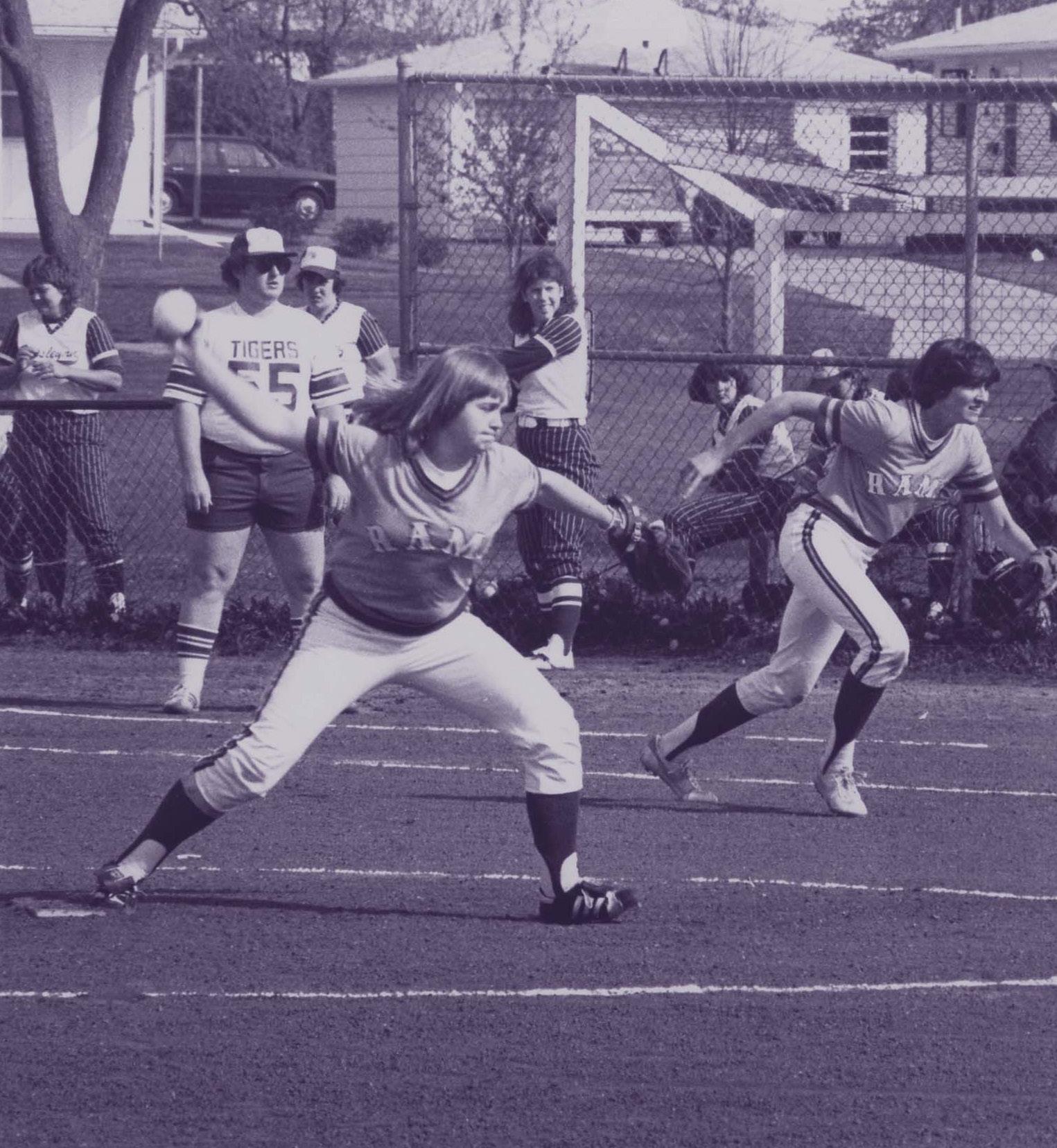

Cornell women demanded physical activities as early as 1889 when the Ladies Battalion began drilling in skirted uniforms behind pews in King Chapel. By 1901 the college had a director of women’s physical training, providing opportunities in a variety of mostly intramural sports. Intramural and club activities continued until 1972 when Title IX resulted in increased access to women’s sports at the collegiate level, including at Cornell.
Title IX is powerful because it is about more than equality or even equity, says Heather Benning ’95 , executive director of the Midwest Conference (MWC), for which Cornell is a founding member.
“It’s about social justice,” she says. “In our society we don’t yet have a collective lens on human rights and equity of opportunity. We as a society are not at a place where we approach life always asking the questions:
Unlabeled image from a 1986 intercollegiate volleyball match. The sport began at Cornell in 1974.
CORNELL COLLEGE ARCHIVES/BOB CAMPAGNA
Sarah McCrea ’84 pitches as Carolyn Kingland-Hanson ’86 charges in an early intercollegiate softball game. The sport began at Cornell in 1977–78.
15
CORNELL COLLEGE ARCHIVES/BOB CAMPAGNA
Is this equitable? Why is there difference? Should there be change? Equity doesn’t have to be equality, but we need to be having those conversations all of the time and be active citizens in it. It’s not about sport; it’s about equity and fairness and education.”
When Ellen Whale arrived in 1978 as assistant professor of physical education and volleyball coach, she had those hard conversations—including when several recalcitrant male coaches balked at remodeling the wrestling room into a women’s locker room.

“Women’s sports were perceived quite differently from men’s sports,” Whale says. “The philosophy of women’s sports was decidedly tilted toward intramurals. Competitive sports were seen as unfeminine and possibly damaging to women’s bodies.”
In her early years she recalls women’s tennis and volleyball teams shared one set of warm-ups while the softball team used cast-off men’s practice pants for their uniforms.
Some of the men’s coaches championed women’s athletics, notably athletics director Barron Bremner, as well as men’s
“Should there be change? Equity doesn’t have to be equality, but we need to be having those conversations all of the time and be active citizens in it. It’s not about sport; it’s about equity and fairness and education.”
HEATHER BENNING ’95 EXECUTIVE DIRECTOR MIDWEST CONFERENCE (MWC)
Rachael Adewusi ’24 drives for a goal against Coe College.
16
CORNELL COLLEGE SPORTS INFORMATION
soccer coaches who allowed women to join as early as 1974— well before the establishment of the women’s team in 1989.
Other milestones include Cornell’s first female national placewinner, swimmer Laurie Needham ’83 in 1980. The following year the women’s track team won the Midwest Athletic Conference title. And in 1983 Pauline Henry ’85 became Cornell’s first female national champion, in the long jump.
Not only has Title IX increased competitive opportunities for women, it has provided them with more female role models in male-dominated coaching and athletic administrative positions, says Lindsay Knake, Cornell’s assistant athletic director, senior woman administrator, and assistant women’s basketball coach.
“Having strong female leaders to mentor our female student-athletes is so important to their experience and shows them that there are opportunities for them to pursue a career in athletics,” she says. “Participating in sports has so many physical, mental, and social benefits, and we are setting our young females up for more success in life by providing these athletic opportunities.”
The recent addition of women’s wrestling (starting competition in 2023) gives Cornell 10 men’s and 10 women’s teams. For over a decade women’s sports have been more successful overall than men’s sports at Cornell. This past academic year volleyball won its ninth consecutive MWC regular-season championship and qualified for the NCAA Tournament for the eighth time in 11 years. In 2021 Cornell landed the MWC Woman of the Year for the fourth consecutive year.
Today 41% of students participate in intercollegiate sports, a number buoyed by the many women who compete. We have evolved from the days when there was a new men’s gym (when the Fieldhouse opened in 1953) and an old women’s gym (the 1909 Alumni Gym). As we look forward to the opening of the $19.5 million Athletic and Wellness Facilities Project in August 2022—a contemporary and welcoming health, wellness, and sport center for all students, faculty, staff, and alumni—we can appreciate that it is addressing the essence of Title IX as noted by Benning: equity, fairness, and education. The new space, known as the SAW (Richard and Norma Small Athletic and Wellness Center), has implications beyond athletics, impacting physical and mental health needs of all members of the Cornell community.
Do you have a pre- or post-Title IX story to share? Contact us at cornellreport@cornellcollege.edu
The grandmother of women’s athletics
Before there was Title IX, there was Mary MacLeod. Seventy years prior to the federal law that opened women’s access to athletics, MacLeod established a culture of greater acceptance and popularity for women’s athletics at Cornell College.
After earning degrees from Cornell (1892) and the Boston Normal School of Gymnastics, she returned as director of physical training for women from 1901–1920. Under her leadership intercollegiate women’s athletics began with a win over Coe College in basketball in 1902. Although just one intercollegiate game was held that year, the yearbook noted there were 60 to 70 women in a tennis club, 25 in golf, 22 in field hockey, and two volleyball teams.


According to “Memories of a Bloomer Girl” by Mable Lee (1977), MacLeod was the first professionally trained physical education teacher at an Iowa college. In 1905 she also became dean of women.
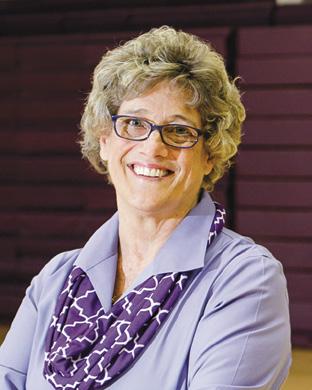
WEB EXTRA
Ellen Whale discovers a space in the SAW is named for her. See the video: crnl.co/whale
Mary MacLeod, 1904 Royal Purple
Early Cornell women’s field hockey team (undated)
17
CORNELL COLLEGE ARCHIVES
Shawn Henning ’96
In the summer of 2013, as Shawn Henning ’96 set out for a meeting with a client, his vision suddenly blurred. “I don’t think I can take notes,” he told a colleague.
Four months later, at the age of 40, he was blind.
Henning’s vision had been damaged in infancy by a rare disease called Stevens-Johnson syndrome. Doctors thought that this condition, combined with certain medications, had caused pressure in his eyes to flare up and leave him sightless. Surgeries and other treatments were useless.
At the time, Henning was a computer engineer for a major consulting firm in Seattle, an expert in programming and software with 14 years’ experience at Microsoft. Now on medical leave, he began teaching himself to use the assistive technologies built into computers, such as turning text into speech. It was harder than he thought it should be, but he mastered it.
“The real problem,” he said, “was leaving the house.”
He sought training in orientation and mobility: basic living skills, use of a cane, beginning Braille. He took lessons in echo-location, learning how to judge the size of a room by clapping his hands, how to detect obstacles by clicking his tongue.
“I was able to get to most places on my own or with help from sighted passersby,” he said. “But many streets were still scary to cross.”
Within months he was back at work, focused on improving assistive technologies and website accessibility. He devoted four years to the effort, during which he married Seth Mahoney, who provides data reporting for healthcare companies. Then Henning landed a job with Apple as an engineering project
manager, moved to San Francisco with his husband, and acquired a guide dog, a yellow lab named Delancey.
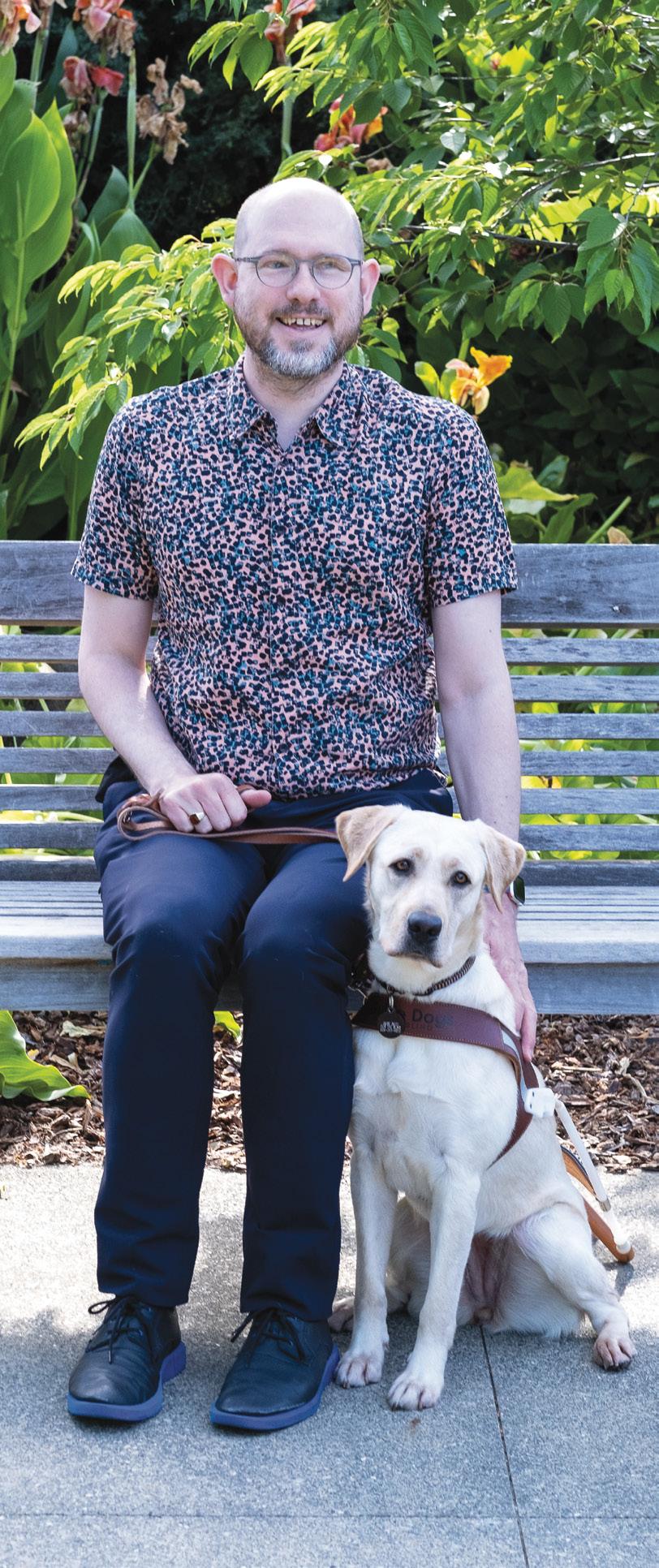
How does Henning explain the urgency with which he addressed his blindness? “I want to work, to be out in the world, use my skills, give value. There are many examples of blind people leading productive lives. People are presented with new challenges all the time. You don’t start out with the idea you can’t do it.”
Computers have fascinated Henning since he took a programming course in high school at Hebron, Nebraska. “I was intrigued by the power of what could be accomplished with keystrokes.” The kid who had nearly flunked his personal typing class became the fastest typist in the school.
At Cornell, he majored in computer science, physics, and mathematics. “Cornell was excellent preparation for working in software development,” he said. “Projects are typically broken into segments with specific deadlines, often a month long, much like Cornell’s block plan.”
Henning also helped create Cornell’s first website, taught others how to make personal web pages, and figured out how to enlarge fonts on a UNIX system, making it easier to use by students with poor vision.
One day, he visited the home of a retired professor, Walter Stromer, who was blind, and helped him set up a bulky scanner that would “read” books aloud. “Just think,” Henning said. “What it took that pile of equipment to do back in 1996 I can do today with my phone.”
— DAN KELLAMS ’58
After a public relations career spanning nearly 50 years in New York City, Dan Kellams wrote two books set in his hometown of Marion, Iowa.
“I was intrigued by the power of what could be accomplished with keystrokes.”
18 LIFE AFTER CORNELL
GUIDE DOGS FOR THE BLIND, SAN RAFAEL, CALIFORNIA
ALL-AMERICANS TODAY
Earning all-American status takes hard work, talent, and skilled coaching. Cornell College’s all-Americans excelled at the highest level in their sports, earning national recognition, all while getting an education and competing in the sport they love.
These disciplined student-athletes often continue their winning ways long after graduation.
Meet six all-Americans today, and learn how they benefited from their experience as a Cornell Ram.
19 CORNELL REPORT | SUMMER 2022
Chris Heilman ’08
Three-time All-American in wrestling
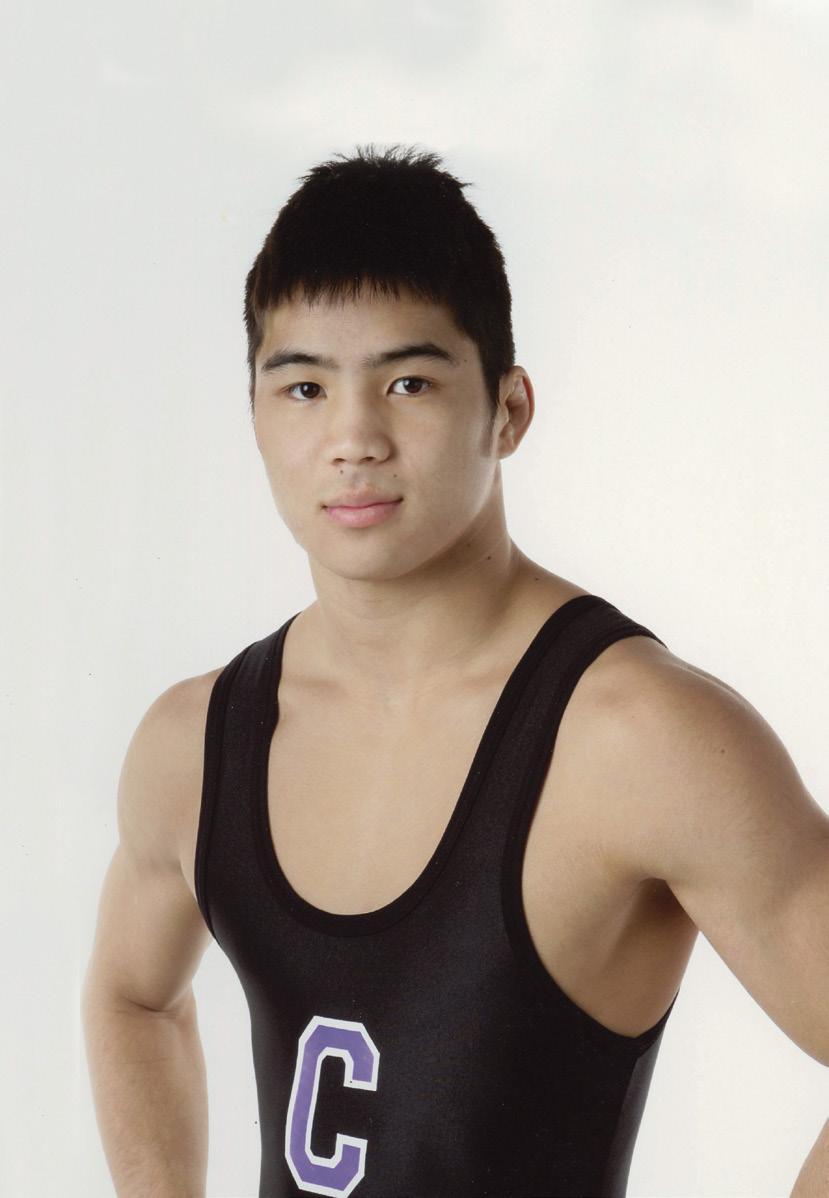
■ B.A., physical education, secondary education
■ Master’s degree in sports management, St. Cloud State University, Minnesota
■ Assistant coach and recruiting coordinator, United States Air Force Academy, Colorado Springs, Colorado (Heilman’s hometown)
■ Married to Jenn Boaz Heilman ’09; two children
What’s a lesson you learned from a coach, teammate, or faculty mentor?
When I first started wrestling, I only saw it as an individual sport—it is only you out there, your team or coaches can’t come save you—and that’s what I loved about it. However, there were times where I could be selfish in my training and life. Coach Mike Duroe helped me realize that it wasn’t all about me, that the team and program came first. For that, I will forever be grateful.

What was a significant failure you faced, and how did you overcome it?
At the time, not winning the national championship seemed like a huge failure. I poured everything I could into it and expected to win. I was the No. 1 seed going into the tournament for the first time and was feeling great. I did feel pressure as Cornell hadn’t won a national championship in quite some time, and I really wanted it to be me.
Unfortunately, I lost in the semi-finals for the second year, but was able to come back and finish third. I was really heartbroken for a few months after that. In order to overcome it, I really had to change the way I thought about it.
Eventually, the thought became “if not winning the national title is the worst thing that has happened to me, then I am doing pretty well.” I instead became proud of the work that I and my teammates put into it ... those extra runs and lifts, getting my butt kicked at the Olympic Training Center, the early morning workouts with the team. I appreciated those moments more and more. Also, as a coach, we talk a lot about being able to handle adversity. Coming back to finish third after a difficult loss is something that I am proud of.
BARTHORTON
20 CORNELL REPORT | SUMMER 2022
CORNELL COLLEGE SPORTS INFORMATION
Lynn Schneider Stoller ’05
Two-time All-American in indoor and outdoor women’s track & field shot put
■ B.A., Interdisciplinary, art
■ M.F.A. in graphic design, Savannah College of Art and Design
■ Senior creative strategist at Emspace + Lovgren, Omaha, Nebraska

■ Married to Brian Stoller and living in Papillion, Nebraska
■ Selected to the Midlands Business Journal’s 40 under 40 in 2018 and recognized as a YP (young professional) Changemaker by the Greater Omaha Chamber’s YP Summit
What was a significant failure you faced, and how did you overcome it?
My junior year I qualified and competed in the NCAA Track and Field Championships and unexpectedly broke into finals in 6th place. That alone was a huge accomplishment, but I coasted. I didn’t give it my all in finals thinking of only holding on to a Top 8, All-American finish, and saw the title slip away in the final round. I could have easily been a threetime All-American, but I didn’t seize the moment.
One year later I was in the finals once again, but this time in a much more comfortable lead at 6th place. I almost began coasting again. But after my fourth throw of six, I looked into the crowd and spotted my teammate, Brandi Rheberg Clark ’05. She was the only face not smiling. She had missed the cut for nationals by the smallest margin, and I realized at that moment, her PR [personal record] would have her sitting on the podium with me had she been granted the opportunity to compete.
This was not the time to coast. I was determined in that moment to give my last two throws everything I had. On the next I fell out of the front of the ring. But on the second, and my last throw as a Cornell indoor shot putter, perfection happened. It was the kind of moment you remember over 15 years later. With a perfect glide, and snap of my wrist, I threw the shot put a full 12 inches better than my best mark to date, and a top-three finish was in the books.

I waited 11 years to tell Brandi this story, and when I did, it was in front of the entire 2016 C-Club breakfast at my Hall of Fame induction ceremony. I used the entirety of my acceptance speech to recognize the contribution, accomplishments, and support of my teammate and friend. It was so rewarding to stand in front of Cornell’s greatest athletes and coaches and tell them how talented Brandi was, and how
our competitiveness and “rivalry” was the catalyst of all my athletic achievements. Without Brandi, who had nearly missed the title of All-American and held many of our throwing records while we were at Cornell, I doubt I would have succeeded at the same level, nor have enjoyed the experience quite so much.
But the lesson I learned to overcome adversity was to surround yourself with those that make you stronger and push you to your limits, and never stand on a podium alone. For even in individual competitions, the team is essential to any and all success.
EMSPACE + LOVGREN
21
CORNELL COLLEGE SPORTS INFORMATION
John “Jake” Remes ’80
All-American in football (wide receiver)
■ B.S.S., politics
■ President and general manager for 24 of his 36 years at KARE 11 TV, the NBC affiliate in Minneapolis, Minnesota. Retired in 2021.
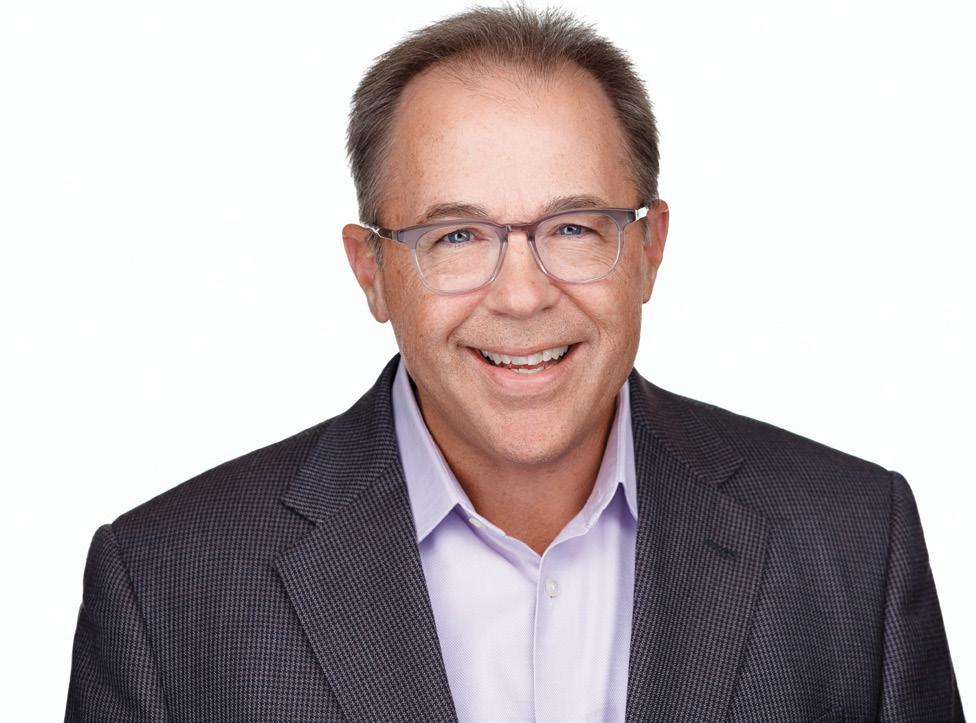
■ KARE was a decorated station for media awards, including many Peabody, Emmy, and Edward R. Murrow awards
■ Married to Sandy Remes; two grown children
How did your athletic experience impact your life?
There are so many parts of the Division III athletic experience that are invaluable–knowledge and skills you are not conscious of in the moment but that become so ingrained they carry you through a lifetime. Teamwork. Leadership. Social skills. Sacrifice. Personal responsibility. These served me whether I was helping a station janitor mop a water leak or leading a boardroom meeting in New York.
Division I athletes on scholarship have their own challenges, but Cornell Rams set their own alarms, make sure they eat properly, get to class and practice on their own, and probably do their own laundry. Don’t laugh. This is discipline. This responsibility gives us an advantage out there. Somewhere in all that, you come to know the world is not always fair and that success or happiness is your responsibility and yours alone.
Leaders can accomplish little by themselves. They share rewards and responsibility and convey confidence in those who join their cause. This unites and energizes people. It makes them feel strong. Ram athletics taught me that.
Most memorable athletic achievement?
I remember all the wins we had. In the late ’70s I think we lost maybe only three or four times. And I remember scoring touchdowns and the joy of running into the end zone, but the lasting memories are the connections and experiences all around the games. The snappy patter on long bus rides. The quiet intensity of pregame prep. Walking onto the field with brothers in arms. Practices that end in the dark, and the defensive back that rarely played, toting his boombox to the showers blaring “Beast of Burden” by The Rolling Stones. Those are my memories. That is my achievement.

22
TEGNA CORNELL COLLEGE SPORTS INFORMATION
Sanjuanita “Sam”
Martinez ’16
Six-time All-American in women’s cross country (2), women’s indoor track & field (2), and women’s outdoor track & field (2)
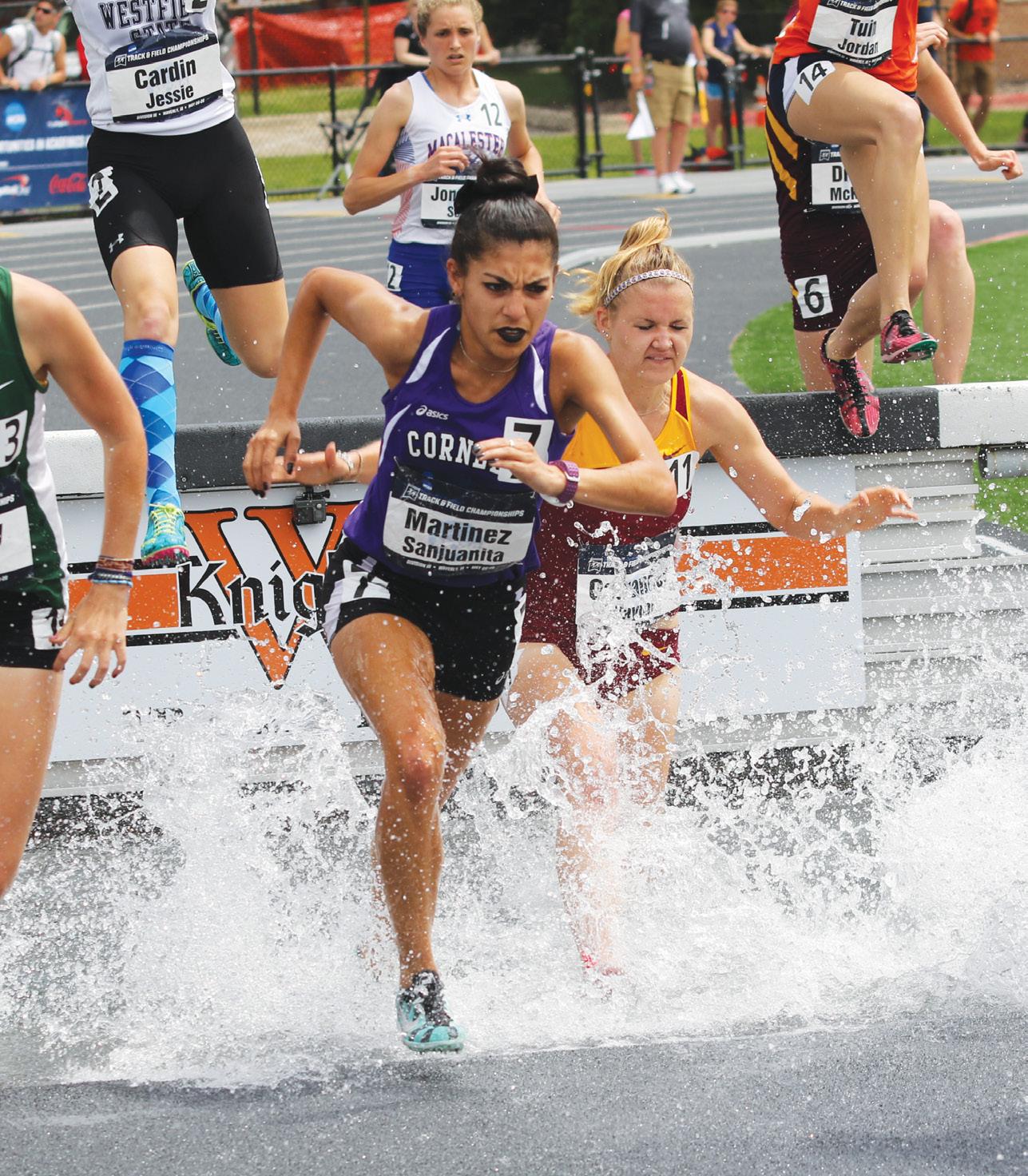
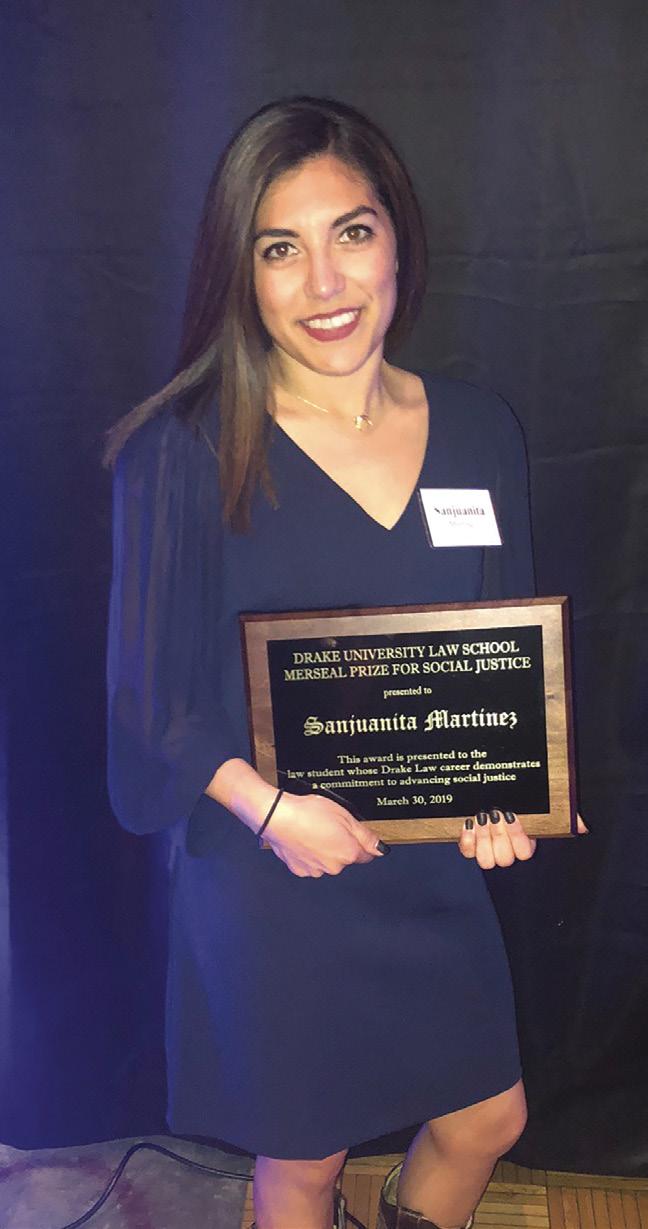
■ B.A., philosophy and Spanish
■ J.D., Drake Law School
■ Defense attorney with the Mason City, Iowa, Public Defender’s Office
■ Assistant high school cross country and track & field coach, Mason City High School
■ Engaged to Patrick Mason; one son born March 21, 2022
What was a significant failure you faced, and how did you overcome it?
A significant athletic failure I faced was my inability to repeatedly qualify in the indoor mile. I qualified the winter of my junior year, but come senior year I just wasn’t running fast enough. I decided to try something new—the indoor 5K— mainly to see what I could do, as I’d never raced that distance before and to start strategizing what I would be racing at Conference to do my part in helping the team scores. To my surprise, an event I had always said I’d never do ended up being the event to guarantee me an appearance at Indoor Nationals. Sometimes the path or direction you take doesn’t always work, and refocusing can help you achieve the same goals, just in a different way. I use that same approach to this day. After graduating from law school I failed the first bar exam by less than 10 points. I refocused and approached it a little differently the second time and scored far higher than necessary to pass.
What’s a lesson you learned from a coach, teammate or faculty mentor?
As a freshman, I was very lucky to have captains and upperclassmen on the team who were empowering and supportive. I was never ridiculed or dismissed for having dreams and goals that didn’t exactly match my performance at the time. The biggest lesson I learned from them was that one person doesn’t make a team and a team can take you further than you could ever imagine. It didn’t matter how fast I ran. Without my amazing teammates, we wouldn’t have won the Midwest Conference Championship meet. If it weren’t for my teammates’ support, I wouldn’t be where I am today.
23 CORNELL REPORT | SUMMER 2022
CORNELLCOLLEGESPORTSINFORMATION
Jeff Maples ’89
All-American in men’s cross country
■ B.A., history, economics and business
■ Manufacturers’ representative in the plumbing industry, Phoenix, Arizona
■ Received awards from manufacturers for largest percentage growth and Rep of the Year
■ Participates in USA Track & Field (USATF); on 4x800 team that won nationals; set Arizona state record at age 30; on 4x800 state recording-setting team in the 50-year-old bracket
■ Married to Lannie Maples; four children
How did your athletic experience impact your life after Cornell?
Being a student-athlete gave me focus. I had to balance my class time, studying, workouts, and meets. I think it’s the competitive drive from sports that has helped me.
I still run and participate in USATF to this day. Running has kept me healthy, maintained a competitive mind frame, and I have developed many friendships. Plus, running has given me the energy to keep up with my kids!
What’s a lesson you learned from a coach, teammate or faculty mentor?
I was so very fortunate to have Ocie Trimble as my track and cross country coach. He was a brilliant race tactician, runner himself, and a salesman. He was in pharmaceutical sales before becoming the men’s and women’s track and cross country coach in the ’80s and ’90s. He also taught at Kirkwood Community College while coaching. He’d always be the last one to leave after our workouts, team meetings, and conversations after our workouts. I truly believe my time around him shaped me for what I am doing today. He said he’d always write down something about the person he’d met when selling and this helped him on his next call on them to develop a relationship. This always seemed to not only get him in the door to meet with the doctor but would end up in a sale.

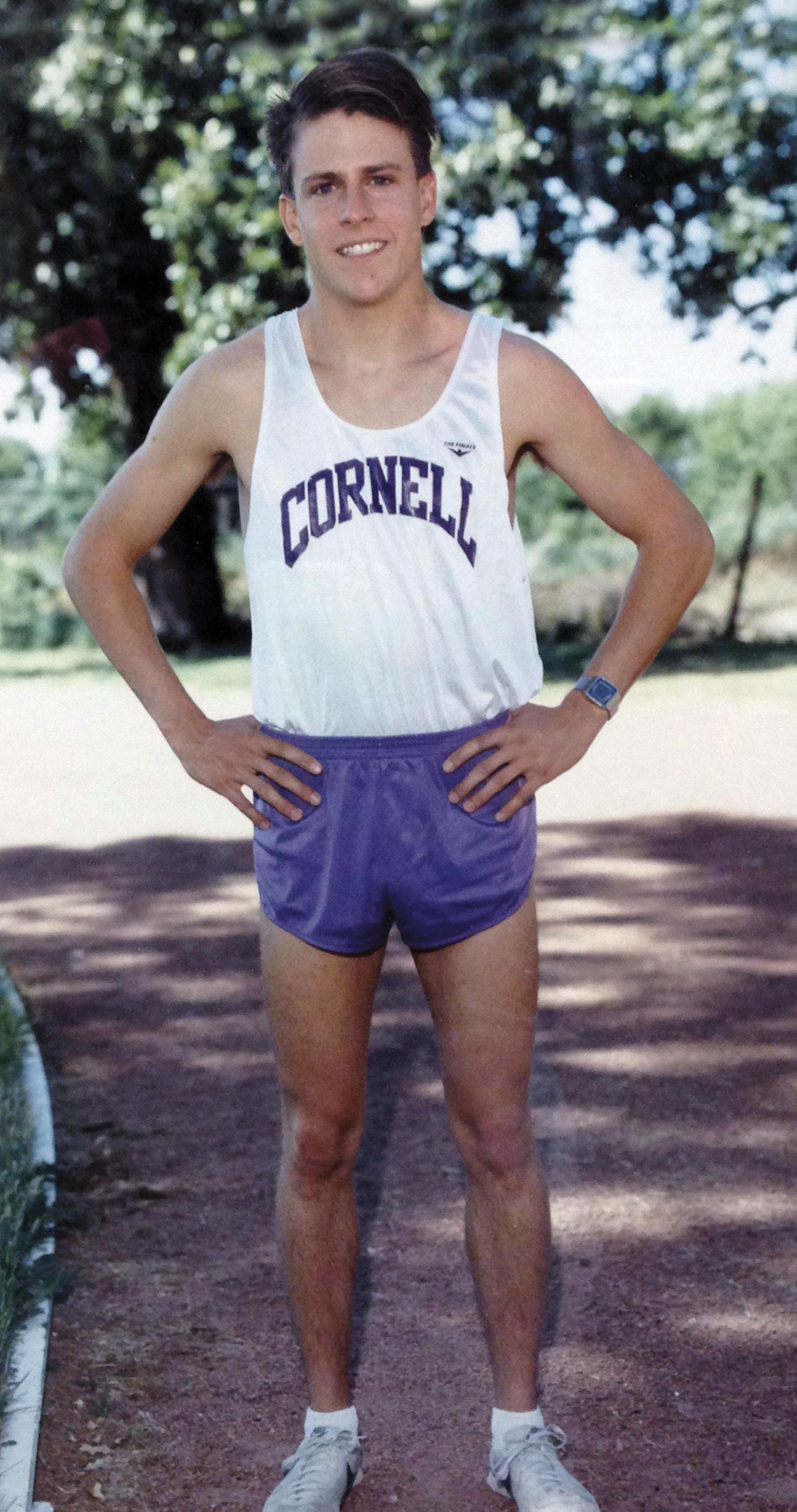
24
CORNELL COLLEGE SPORTS INFORMATION
Kathleen O’Connor ’13
Two-time All-American in volleyball

■ B.S.S., studio art, K-12 education certification
■ Master’s degree in art education, Eastern Illinois University
■ Elementary art teacher and high school volleyball coach in Round Lake, Illinois
■ Founded her school’s Village Viking Art Club, began a Legacy Rock Garden, created digital portfolios for student artwork, and was selected to be part of her school’s SILT (School Improvement Leadership Team)

How did your athletic experience impact your life after Cornell?
The major difference between Cornell athletics and other schools was that it was a family; everyone supported each other and their future endeavors. The Cornell volleyball program was not solely concerned with athletic performance; the main focus was about creating well-rounded global citizens. We did community outreach, volunteer work, and had the opportunity to travel to Nicaragua as well as various countries throughout Europe. These experiences have caused me to be involved, travel as much as possible, and try to have as much of a positive impact on people as possible—especially my students and athletes. I want every young individual to understand that they are capable of becoming open-minded citizens who can choose to make a difference in our world.
What was a significant failure you faced, and how did you overcome it?
After graduating I followed a dream to play professional volleyball overseas. Unfortunately, I was not selected for a team and I had to move forward from that failure. Since I was already in Europe, I saw it as an opportunity to see more parts of the world and was able to explore many countries and their cultures. When I came back I took a break from volleyball for some time but have since regained my passion and have played in several Adult USA Volleyball Open National Championships as well as other professional tournaments around the country. These experiences have helped me realize that my love for the game was more about the relationships built and the memories made with friends than just the competitive nature. Volleyball will continue to be a part of my self-care and will always hold a special place in my life.
25 CORNELL REPORT | SUMMER 2022
CORNELL COLLEGE SPORTS INFORMATION
Trang Hoang ’15
Trang Hoang ’15 grew up in Hanoi, Vietnam, and came to Cornell College to pursue a degree in economics. Being away from her family has been her biggest challenge and earning her Ph.D. is one of her proudest achievements.

Now an economist for the Federal Reserve Board of Governors in Washington, D.C., Hoang took her first economics course with the late Professor of Economics and Business Jerry Savitsky, which is what inspired her to major in economics and later get her Ph.D. in economics from Vanderbilt University. She still fondly remembers an array of classes from religion to music theory.
“Having a liberal arts education is very important, not just for my career but because of how it enhances your life with being able to hold discussions about social issues, and I’m very grateful for that. Cornell prepared me through the economics and math courses that gave me a strong foundation to help me power through my Ph.D. I remember others in my Ph.D. program were saying ‘this is so difficult, you need to study really well,’ and I realized that a lot of this I already knew. And, in general, Cornell provided me with analytical skills that I continue to use.”
Outside of the classroom, Hoang was active in Eyes of the World, where she found a great sense of community with members from all over the world. At the end of her senior year she presented at the annual Student Symposium. This project helped her dip her toes into the waters of research and taught her that she could be an independent thinker.
At the Federal Reserve Board Hoang helps maintain the giant machine that influences the U.S. monetary policy to promote maximum employment and price stability. Her area of expertise is forecasting U.S. trade (goods and services). She has to stay on top of the relevant events that could impact trade—from the blockage upsetting shipping in the Baltic Sea to flights not being able to cross borders due to war. That kind of monitoring and evaluating of events requires a lot of resources, which is why Hoang is among 400 economists tracking and analyzing information.
She values people and relationships and intentionally works to keep her Cornell connections. They include faculty, friends, and her host family, Professor Emeritus of Psychology Carol Enns and her husband.
“The people I met at Cornell have turned into long-term relationships,” she says. “They have become very important people in my life.”
She considers her family her biggest supporters.
“My mom always wants me to do the best thing for me,” Hoang says. “She is the best mom ever, so giving, so loving, and has always put her children above her needs. And that is the reason I have been able to make it here in the U.S.”
— LISA GRAY GIURATO
“The people I met at Cornell … have become very important people in my life.”
26 LIFE AFTER CORNELL
ZOEY NGUYEN
The Hilltop’s HIDDEN SPACES
On a campus with 48 buildings dating as far back as 1850, there are always treasures that have yet to be discovered. On these pages we reveal 10 spaces that most people rarely see, but that serve important functions in the daily life of the college.

27
Photos by Megan Amr
The Van Etten-Lacey House is home to the Center for the Literary Arts, where classes meet, student-lit mag staff pore over submissions, and guest writers conduct readings of their work. What isn’t as well-known is that down the stone steps and beyond the mechanicals room is the Washington Press Room, home to a Washington letterpress. When you open the wooden door covered in printed posters, you’re met with a sun-filled room, and suddenly you feel yourself transported back in time, where printing was an art form that required a hands-on approach. You feast your eyes on all the pieces used to create the inked indentations into the paper and remember the tactile experience of handling the papers used to create posters, cards, and books.

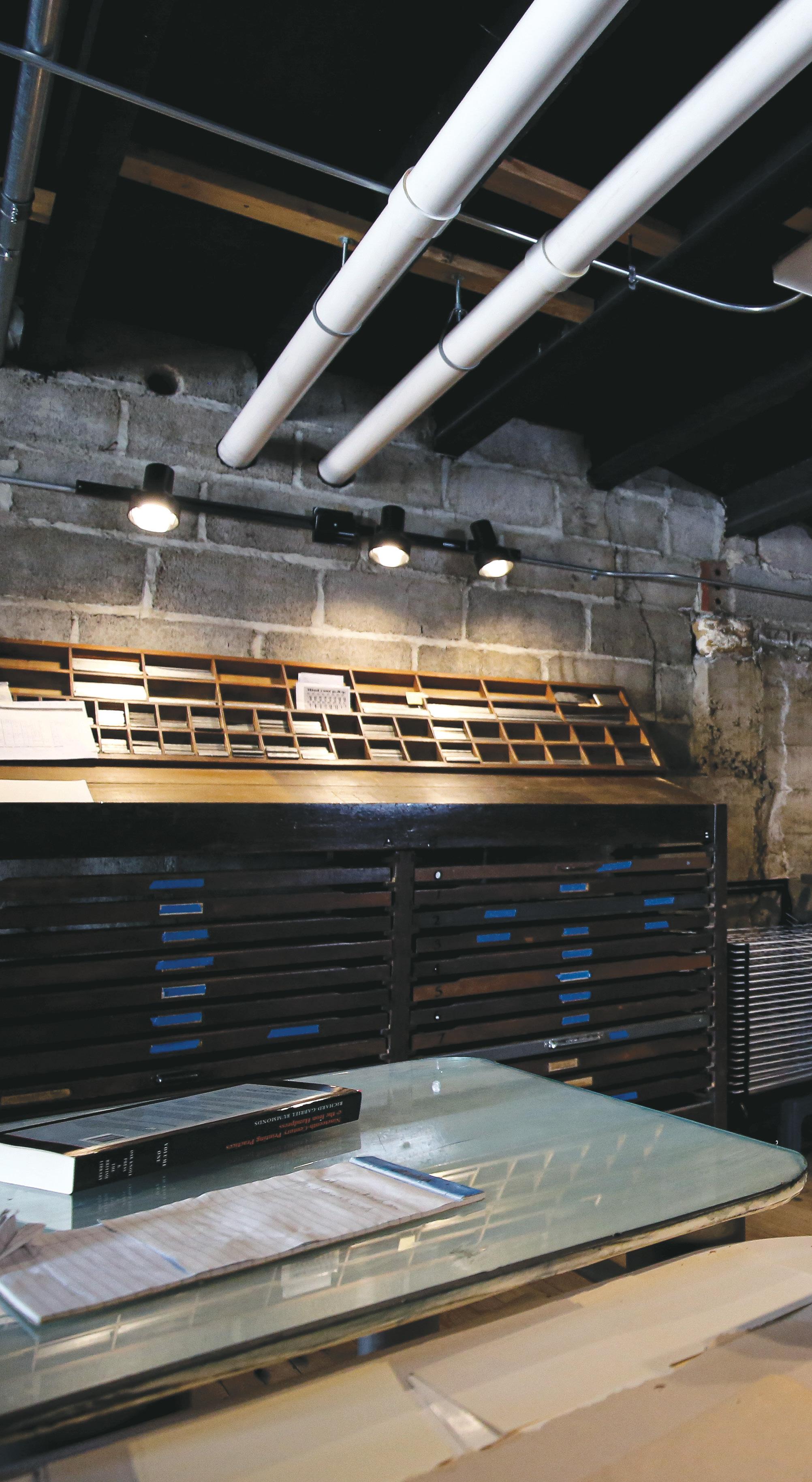
28

29 CORNELL REPORT | SUMMER 2022
Cornell’s Mail and Service Center, tucked in the back of the lowest level of the Thomas Commons, is a spacious, well-lit area run by two full-time staff with nine students (including Lily Heinzel ’22, above). In addition to design and printing services, this team processes all incoming and outgoing mail plus approximately 27,500 packages a year. There are over 1,600 mailboxes, one for each student, faculty, and staff member.


30
In the northeast corner of Allee Chapel is a qibla wall facing Mecca for Muslim prayer. This space was established by a local imam after two prayer rugs (one on the floor, the other rolled up nearby) were given by the mother of sisters Roshan Iqbal ’00 and Roohi Iqbal ’00.
The nearby shelf holds resources to support a variety of traditions including Qurans, a book of common prayer, and Jewish prayer books donated by Temple Judah in Cedar Rapids. The chapel is open daily during the school year for individual meditation and group worship.

31 CORNELL REPORT | SUMMER 2022
Once a coveted dorm space known as the Sky Room, the Scott Alumni Center’s Call Center is staffed by eight students who contact Cornell alumni and parents by phone. These student ambassadors log more than 550 hours a year, making 20 to 30 calls an hour. Last year they generated over $72,000 in gifts as they made personal connections with each donor.



Armstrong House is named for Cornell’s first Black graduate, Frank Armstrong, Class of 1900, and later a physician in Chicago. This older home next to campus houses six students, provides programming space for BACO (Black Awareness and Cultural Organization), and is a safe space for students of color. “The first floor is open to all students who may need time to get away from their roommate or a stressful situation,” says Anthony Pilgrim ’23, a member of BACO’s executive committee.
FROM LEFT: Kimberly Maitland ’24, Quelinda Matos-Joaquin ’24, Lena Cheatham ’24, and Anthony Pilgrim ’23

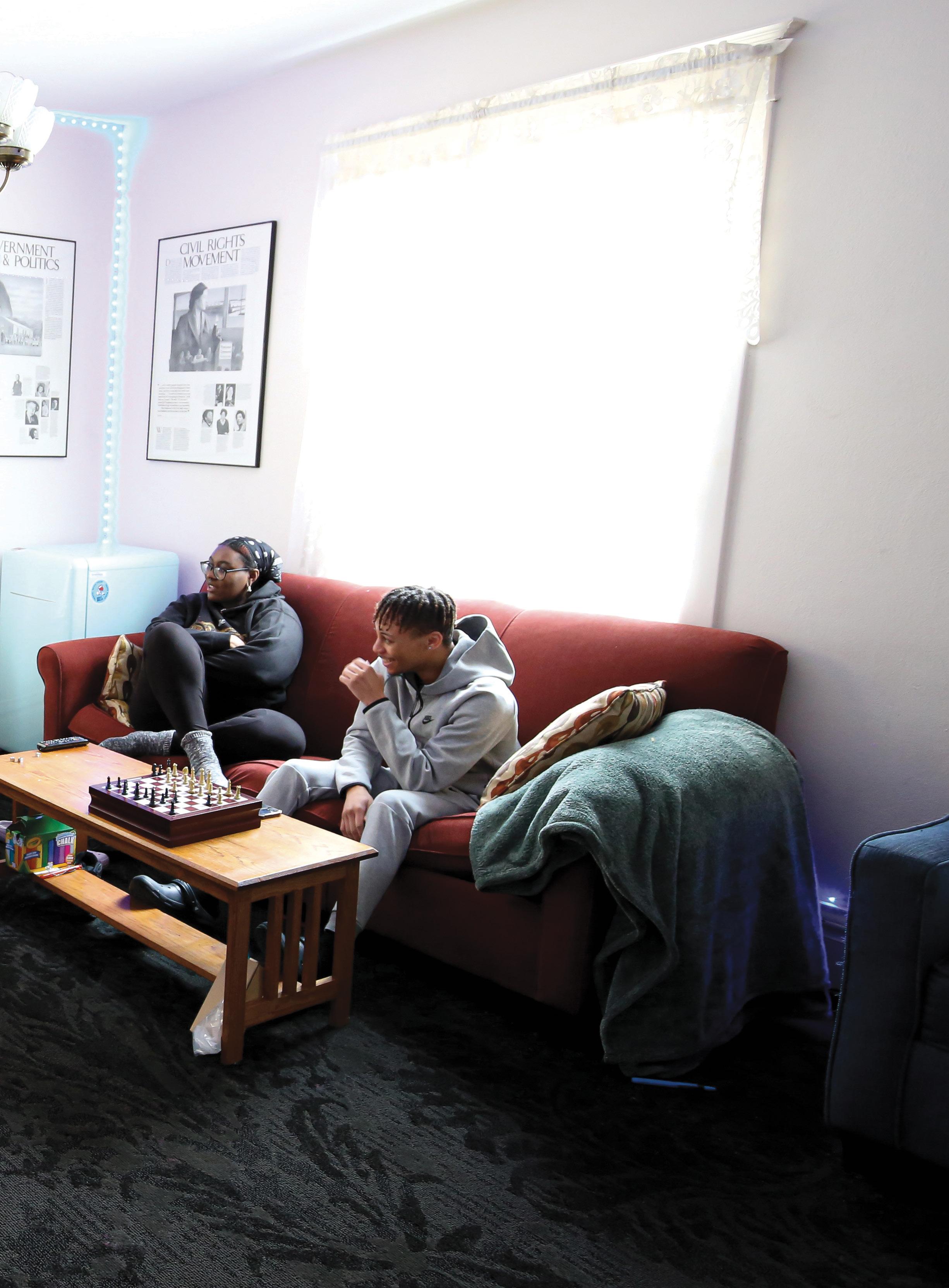
35 CORNELL REPORT | SUMMER 2022
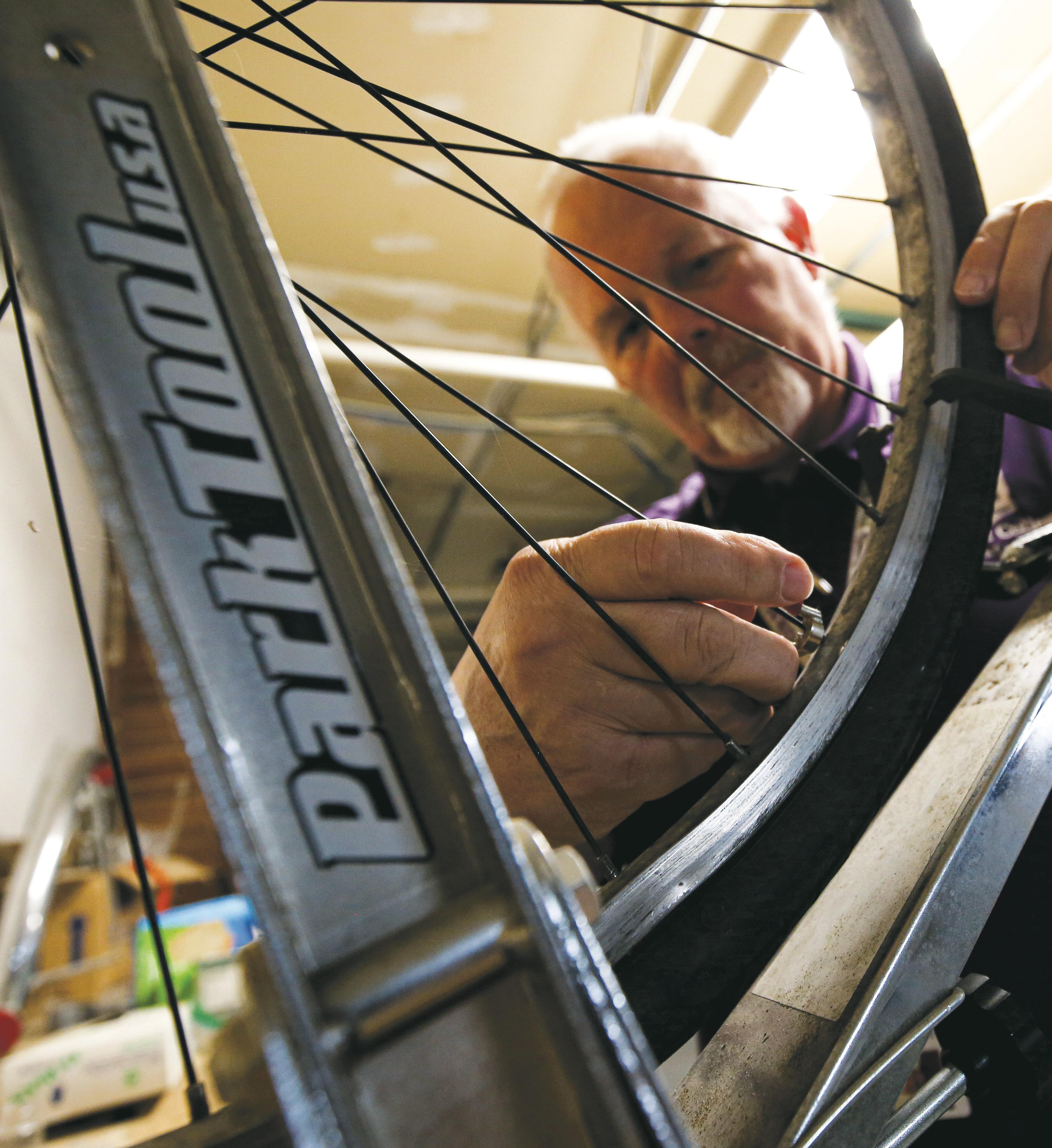
36
Tucked away under BowmanCarter Hall is the Cornell Purple Bike Shop. It’s easy to miss even with a welcoming bike tire wreath hanging on the window when the shop is open. Director of Campus Safety Mark Winder (at left) oversees the shop and the program that lets students check out a purple bike to take for a spin. It’s a bike library, of sorts. Need to store your own bike out of the weather? They do that too. Need your bike fixed? Student workers employed at the shop can take care of your broken down flat. If Winder spots students cruising (or crashing) their own bikes on campus, you can bet he will be tapping them on the shoulder and asking them if they want to work in the Purple Bike Shop.
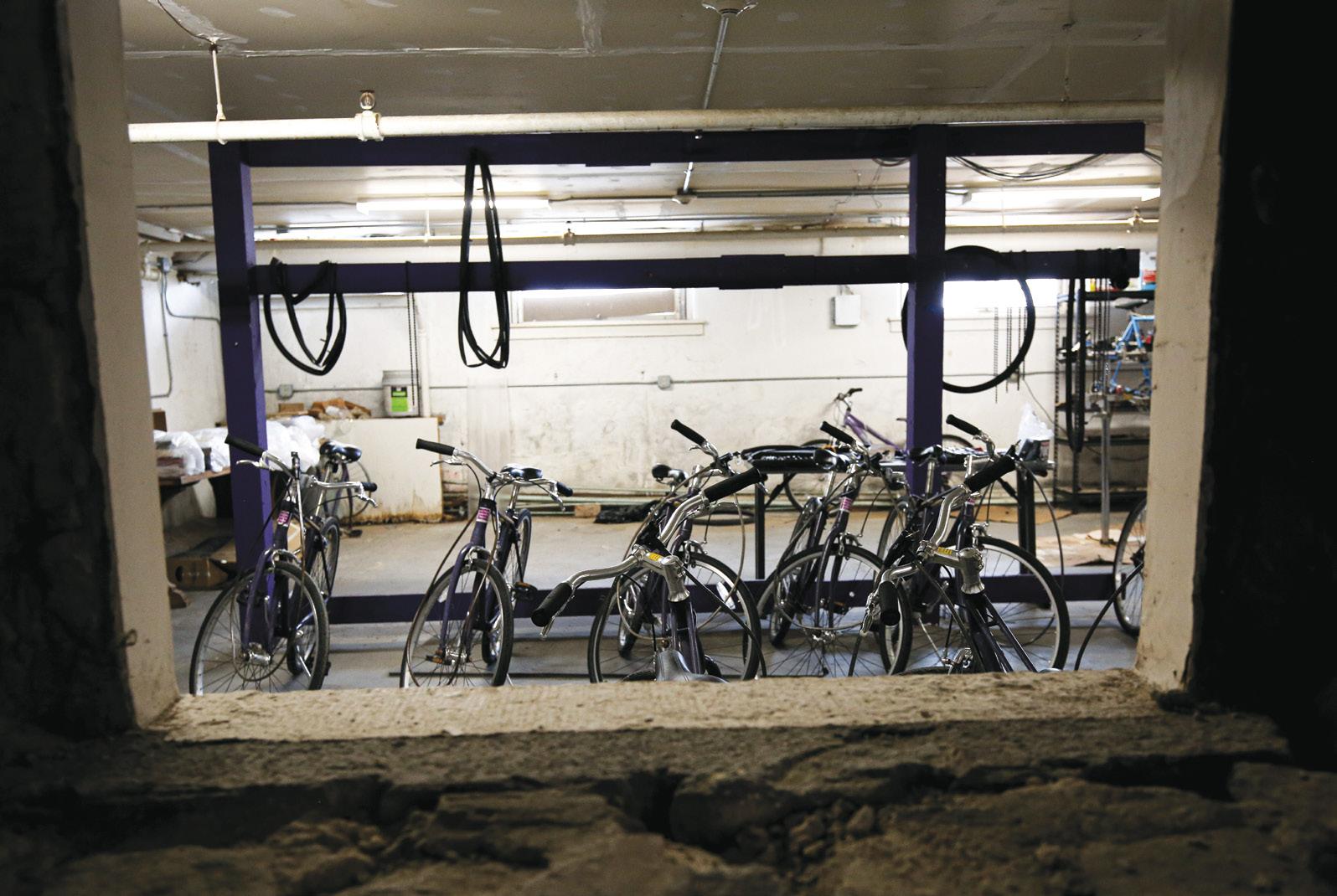
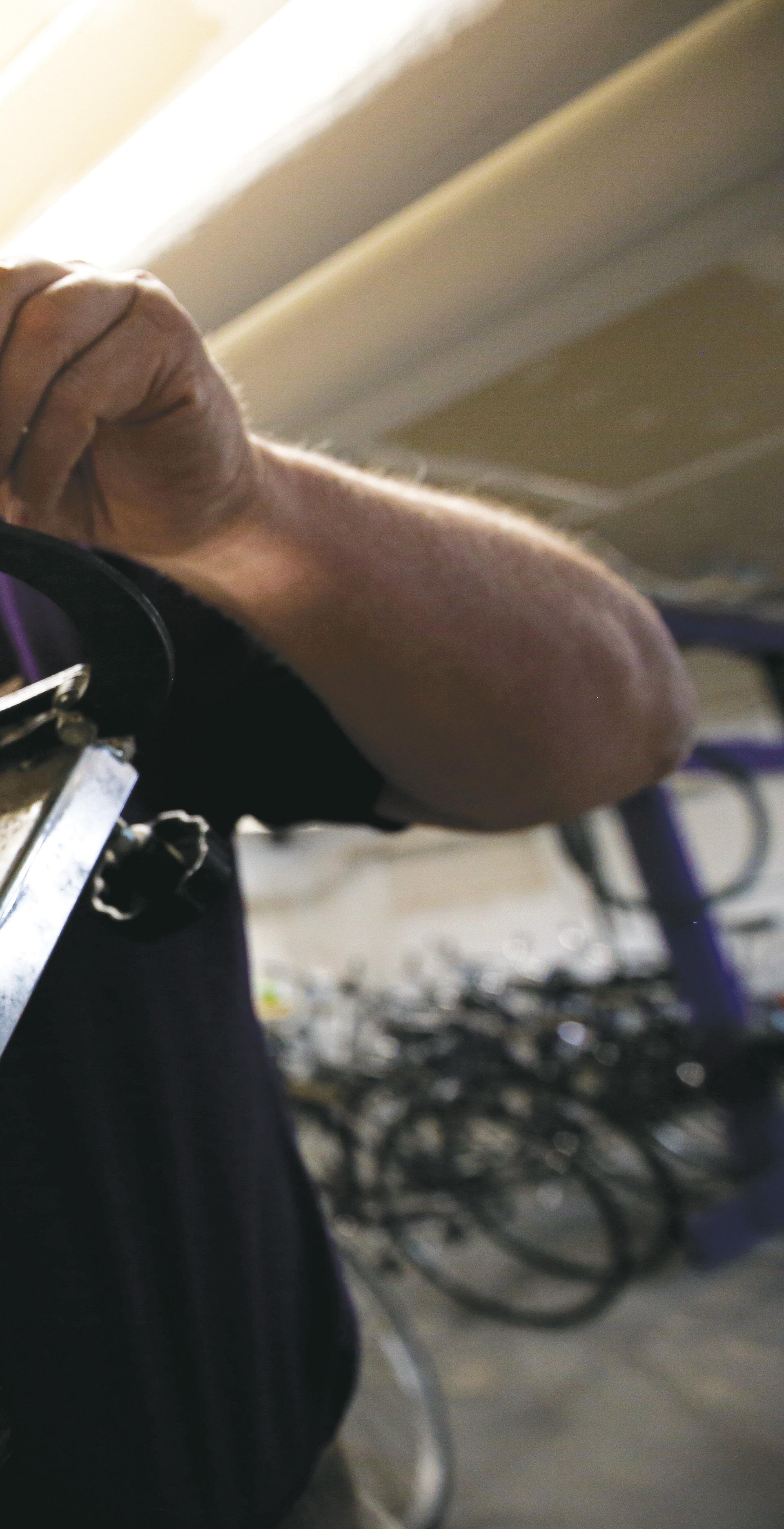
■
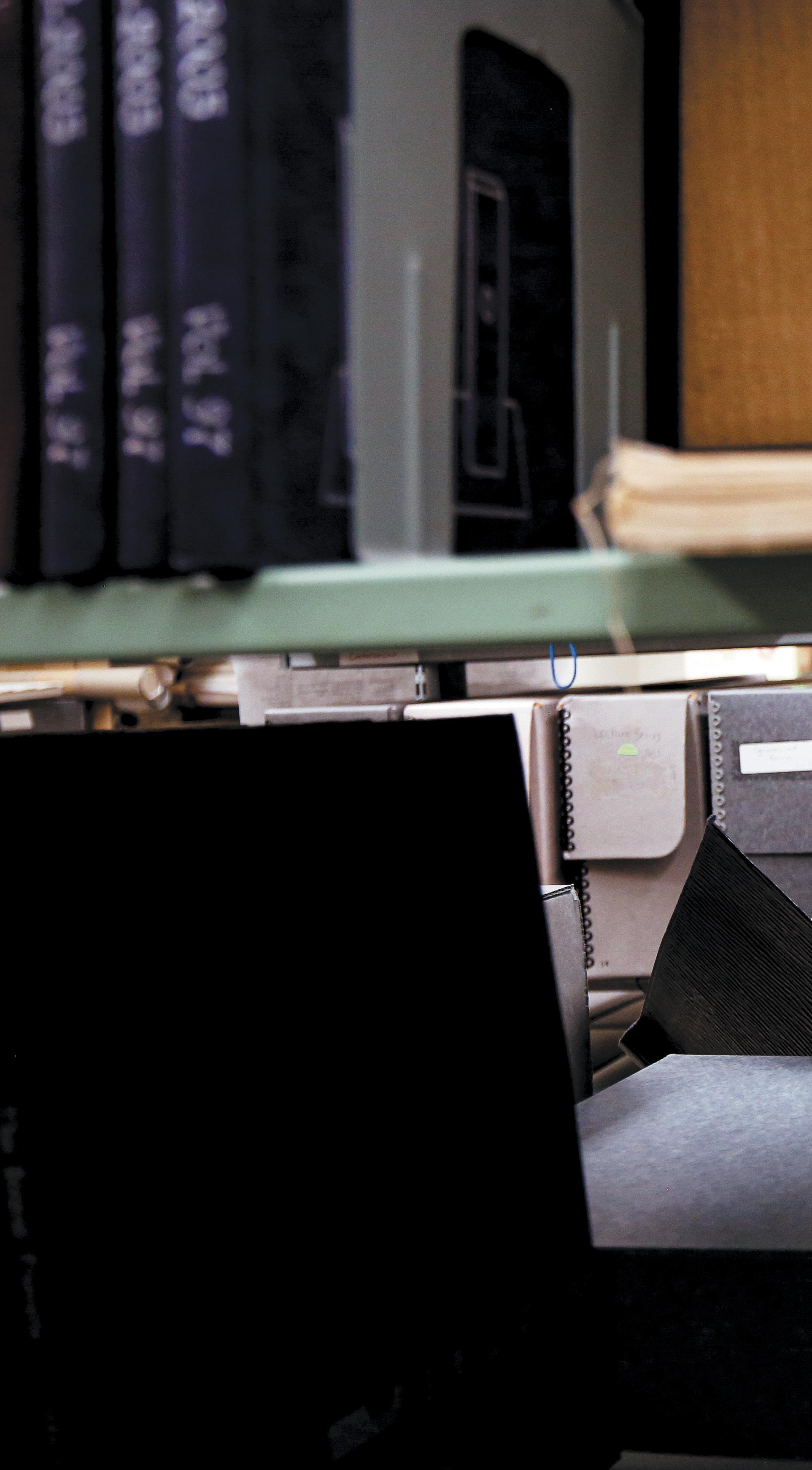
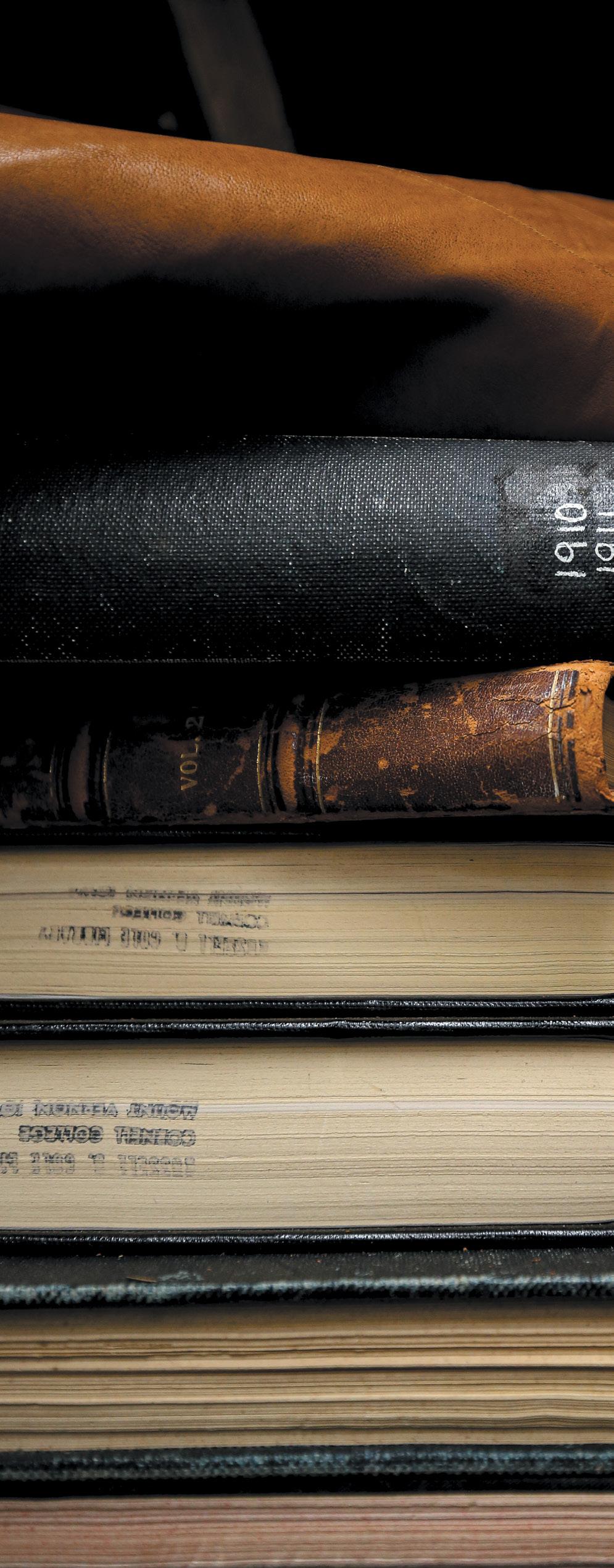
College Archivist Meghan Yamanishi oversees the College Archives, a two-room, temperature-controlled space on the second floor of Cole Library. The space is dedicated to preserving Cornell’s history and its various artifacts, alumni memories, and faculty and administrative odds and ends. To say the Archives is eclectic is an understatement. If you enjoy the unusual, there’s a good chance Yamanishi has seen it and can locate it within her realm. Yamanishi has many favorite items in the Archives including Cornell’s less-well-known history, like photos and stories of Black students from the 19th century, a banister newel post with a hidden interior from an old boarding house in Mount Vernon, the many donated scrapbooks from alumni, and a stereograph photo viewer. 38

■ 39 CORNELL REPORT | SUMMER 2022
Students have had access to cadavers on campus since 2002, rare for a small college without a nursing program. In 2021-22 one female and one male cadaver were stored in a small room off the Kirkpatrick Anatomy Lab in Russell Science Center, and brought out during lab sessions. The cadavers are kept at room temperature and covered by towels moistened with embalming fluid. At the end of each year they are returned to the Deeded Body Program at the University of Iowa for cremation and a memorial service.
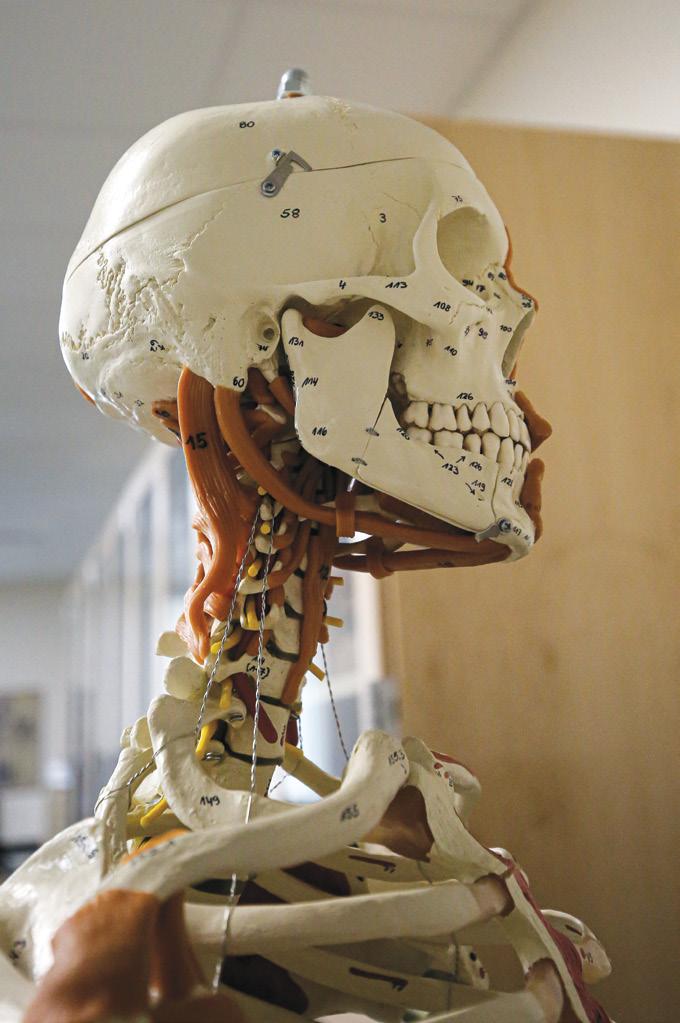


CORNELL REPORT | SUMMER 2022

41
The press box at Van Metre Field at Ash Park was built in 1991 by Steve Miller ’65, Jim Wallace ’68, and Doug Van Metre ’50, and renovated in 2018. It is abuzz with gameday personnel for home football, track and field, and lacrosse competitions. Sports information staff, media, scoreboard and timing/ clock operators, and an announcer (in this case, Zach Perry ’24) occupy the main level. The upper level includes coaches’ booths on the ends, with the center section used by home and visiting videographers. Photo by Ray Borchert ’24.

The only time you’ll spot all the facilities vehicles lined up at the Facilities Services building south of campus is when the staff ends their work day. From big projects to small items, a dedicated Facilities Services team builds, repairs, maintains, and answers the call across campus when and where they’re needed—no matter if it is a sunny, humid afternoon or an icy cold winter morning.
Do you have a hidden space in mind that we did not cover?
Tell us about it by emailing cornellreport@cornellcollege.edu

Alumni News
 Tom Adams ’63, Nancy Kleihauer Adams ’64, John McGrane ’73, and Marty Benson McGrane ’73
Tom Adams ’63, Nancy Kleihauer Adams ’64, John McGrane ’73, and Marty Benson McGrane ’73
44
(from left) vacationed at Hawai’i Volcanoes National Park in January.
1950s
Peg Bohstedt Kahr ’58, lives in Tellico Village, Tennessee, where the local library needed significant fundraising, and Peg took the role of fundraising director. She is also chairperson of the local chapter of the American Wine Society. She and her husband, Doug, toured Shiloh National Military Park and traveled to Natchez, Mississippi, where they explored antebellum homes.
Jon Reynolds ’58, Marion, Iowa, has many stories to tell from his overseas years in education. He spent much of that time in Bahrain, where he assisted the king’s son in establishing a merit scholarship program that sent students to universities in the U.S. Jon met the students when they arrived and personally took them to their college, then helped them get settled and acclimated. “It was a challenging and sometimes difficult life in Bahrain, but very rewarding too. The best of my professional career,” he wrote.
1960s
After law school and six years in Seattle and Los Angeles, John Beamer ’61 settled in Des Moines, Iowa. He has sung with the Plymouth Congregational Church choir for 37 years. He did not sing at Cornell, and says he did not inherit his music teacher mother’s abilities.
“Over the years I learned that choir is like prime real estate— location. If you stand next to a person who has skills you might lack, one can do just fine,” he writes. “Besides, I imagine the choir director appreciates the contribution I bring to the choir: volume.”
Nancy Ness Broadway ’61 writes that one thing about living in Brooklyn, New York, is that she not only has her garden, but a whole block of trees to enjoy.
Carol Parish Compton ’61, Madison, Wisconsin, reports three important events took place in the last half of 2021 for her and her husband, Lin. Their son and his family of five bought a house in Madison after living with Carol and Lin for over a year. In October they took their first trip in many years to Minnesota’s North Shore, where they had a family cabin for nearly 50 years. In November their nephew Andrew Johnson ’14 visited.
Ann Archer Harsh ’61 and Dave Harsh ’61, Madison, Wisconsin, write that 99% of the residents in their retirement community, Oakwood, are vaccinated, and thus it offers a sense of serenity. They have taken a couple of brief trips to Door County, Wisconsin, spending most of their time experiencing the beauty of the outdoors. They also flew to North Carolina for a family Thanksgiving. Dave continues to serve on the United Methodist Board of Global Ministries and on a Bolivian task force. Ann is now chaplain of her PEO group, as well as secretary for the Oakwood Chamber Players. She enjoys participating in one of Bethany UMC’s book clubs and the Agape Circle (by Zoom this year).
Ort Kolewe ’61, Hinsdale, Illinois, writes that with COVID restrictions he spends time “doing puzzles, making stars, reading, and watching football and TV, as well as wearing masks.” He says he was not getting together with others, nor holding hands with Patti Kjeldsen Kolewe ’64, but was walking the dogs.
As a former Cornell wrestler, Jack Sunderlage ’61, Lehi, Utah, has had the opportunity to be a mentor to the wrestling coach and university president for Utah Valley University (UVU), the only Division 1 wrestling program in Utah. UVU is a Top 20 ranked wrestling program.
Tom Adams ’63 and Nancy Kleihauer Adams ’64, Pequot Lakes, Minnesota, are planning to build a one-level home just across the road from their current home. The lake property will remain in the family for future generations. They report that the Class of ’63 50th reunion gift, the fireplace in the Thomas Commons, continues to be a major attraction on campus. And the Class of ’63 scholarship continues to grow and provide scholarships every year.
Gene Brouillette ’63 and Linda Buresh Brouillette ’66, Rio Verde, Arizona, were sad to lose their longtime friend Larry Dorr ’63 at the end of 2020. Gene reports he is in good health for an octogenarian. “Golf is not good to me, but I endure,” he writes.
After six months living in Castelnau-le-Lez, France, Carole Baskerville Carson ’63, reports her French language skills are lacking, but she somehow gets by: “My life is so different here that I feel like a different person.” She still writes a newspaper column (Joyous Aging) and has added a second series (Letters from an Expatriate) for The Union Newspaper in Nevada County, California. She’s just moved into a new home that is tiny by American standards, but generous by French standards.
Tim Frazer ’63, Concord, New Hampshire, says he and June celebrated 51 years married and 28 years sober last year. It’s the second marriage for both of them.
CONTRIBUTE
We love receiving updates. Submit your news to crnl.co/classnews
45 CORNELL REPORT | SUMMER 2022
“Over the years I learned that choir is like prime real estate—location. If you stand next to a person who has skills you might lack, one can do just fine. Besides, I imagine the choir director appreciates the contribution I bring to the choir: volume,” writes John Beamer ’61.
Linda Crissey Cotten
Always busy travelers, Bill Horn ’64 and his wife, Judi, of Clermont, Florida, have missed cruises and visiting around the globe during this pandemic.
Becky Martin McLennan ’64 and Bob McLennan ’65, Naples, Florida, traveled to Argentina in February 2020, just before the world shut down, and are now looking forward to traveling again.
Judy Anderson Mettler ’64, Monticello, Iowa, reports that most of her outside activities have resumed at this point in the pandemic, and participation is wonderful.
United Way of Central Iowa, the Food Bank of Iowa, Hope Ministries, Variety, Friends of Des Moines Parks Foundation, and, of course, Cornell College.
Robert Reimers ’66, Houston, Texas, is working as an adjunct professor at Texas A&M and is a professor emeritus at Tulane University. Bob’s Ph.D. is in environmental engineering from Vanderbilt University. “I will be retiring from my business in the next year, and plan to do some traveling and do a lot of vegging,” he writes. His son, Alex, is a Catholic priest and is attending Pontifical Gregorian University in Rome for his Ph.D.
Bill Hovenden ’63, Gallatin, Tennessee, finished his book, “J.D. and Me,” a true story of his life at Alice Lloyd College and the Red River Gorge with a feisty dog. Bill saved the dog from a pack of wild dogs, and the pet came to Bill’s aid when three men tried to steal his bright red ’52 pickup. His editor tells him it may take a couple of years to get the book published.
Jan Lagerstrom Kappes ’63, Ainsworth, Iowa, taught in the Cedar Rapids schools for two years before marrying her soulmate in 1965. In 1969 she earned her master’s degree in elementary education. Forty years of educating students, two daughters, two sons-in-law, and four grandchildren later, she feels blessed.
California State University, San Bernardino, offered two exhibitions by its Professor Emeritus of Painting Don Woodford ’63 this spring: “Formalist without Formula: Don Woodford Selected Works 1972-2022” and “Legacy: Former Students of Don Woodford.” A news release about the exhibit noted, “An artist, educator, curator and collector, Woodford has an extensive and rich knowledge of art, both historical and contemporary … In his long career, Woodford has mastered collage and painting techniques, experimenting in both two- and three-dimensional abstract forms.”
Leland “Bud” Beamer ’64, Madras, Oregon, recently published “The Baby and the Seed: A Primer on Good Parenting a Book for the Entire Family.” He writes that the book had its genesis when he took professor Dorothy Newbury’s course on early childhood. “Entering the field of medicine, and later prison work, I saw lives play out in matters of mental and physical health, according to the nature of the environment in the first few years. It became one of my passions, knowing that if we could educate parents on the importance of love and nurturing, many of life’s mental and physical problems could be prevented.”
Joe Gauss ’64 and April Stan Gauss ’64, Houston, Texas, were unable to be at their island in Rainy Lake while the border to Canada continued to be closed last summer. Joe reports that April’s health is still declining, but she is in good spirits. Joe has two wonderful ladies who help and have become part of their family, allowing Joe to get to meetings, keep the house up, and cook meals.
Sharon Plagmann
Harrington ’64 and her husband, Tom, formerly of Minnesota, are truly enjoying living in Fort Myers, Florida. Family comes for visits, and Sharon’s golf-playing has lessened with the quilting group keeping her very busy. Her group has made over 800 quilts for Project Linus.
Phoebe Green Meyer ’64, Pottsboro, Texas, and her husband, Charles, miss the traveling they have done in the past. Cruises were their high points, and they hope to sail again before too long.
During the pandemic, Donna Nielsen Pfeil ’64, Granger, Indiana, and her husband, Dick, especially enjoyed having a lake home nearby where they spent a great deal of time last summer. While both are involved in many community activities, they are looking forward to being in Florida for the winter rather than Indiana.
Shirley Nelson Swanson ’65, Bloomington, Minnesota, lost her spouse, Richard Swanson ’63, on Aug. 25, 2020.
Cornell Trustee Linda Webb Koehn ’66 and honorary alumnus Tom Koehn, West Des Moines, Iowa, were honored at the 2022 Bravo Awards Gala in February. The award is given annually to a person, family, or foundation whose commitments to arts, culture, and heritage have had a positive effect on the Greater Des Moines region. The Koehns have served on boards or participated in fundraising for organizations including the Des Moines Symphony, Des Moines Metro Opera, Des Moines Art Center, Science Center of Iowa, Greater Des Moines Botanical Garden, Des Moines Performing Arts, Hoyt Sherman Place, and the Des Moines Community Playhouse. The Koehns’ commitment also includes
Linda Crissey Cotten ’67, Las Vegas, Nevada, reports that Ewe Read, an online book club open to women from the Class of ’67 (or thereabouts), came into existence in 2010 and has been meeting virtually ever since. “It’s been a wonderful way to keep our bookshelves stocked, library memberships active, ebook and audiobook competencies alive, and our friendships renewed and strengthened. Not to mention all the traveling we’ve done through the ages and around the globe amidst the pages recommended by our varied members,” she writes. In addition to Linda, faithful Ewe Readers include Portia Peters Bauchens ’67, Susan Leigh Kingston ’67, Carol Monson Reinhard ’67, Caran Oja Riggs ’67, and Raylene Garrison Seramur ’67. Others they have known and loved to see participate are Carol Lace Jenkins ’67, Betsy Beers Shillinglaw ’69, and Julie Dieckman Moore ’67
David Klaus ’67, Washington, D.C., has socialized with small groups of close friends throughout the pandemic. When a couple of them came to his house for a home-cooked meal, he offered them B&B (Benedictine and Brandy)—but then couldn’t find it in his liquor cabinet. This motivated an inventory of some 107 bottles and a map of his liquor cabinet, so that now he can find everything. He hasn’t yet inventoried the wines in his cellar, nor the Brazilian cachaça, which are kept in a separate place.
’67 reports that
46 ALUMNI NEWS
Ewe Read, an online book club open to women from the Class of ’67 (or thereabouts), has been meeting since 2010: “It’s been a wonderful way to keep our bookshelves stocked, library memberships active, ebook and audiobook competencies alive, and our friendships renewed and strengthened.”
Barb Whipple ’67, Houston, Texas, was reading and tanning in the sun outside in January, 2021, then the day after Valentine’s Day—snow! The house was 45 degrees for over two days with no power. She’s been paring down her things and then Jo Eckerley ’69 came to town for a quilt show and helped her start decluttering in earnest. She’s traveling again, still going to the Y, and keeping up with far away friends by phone.
1970s
Sue Mulford Schroeder ’72, Bennett, Iowa, reports that 18 members of the Class of 1972 have been keeping in touch during the pandemic via Zoom about once every six weeks. Participants reside in 12 states, have had numerous occupations before many of them retired, and have very fond memories of their Hilltop years. “These renewed friendships have also led to various members traveling across the country to see dear friends in new states or vacation homes,” she says. Members of the group in addition to Sue: Barb May
Balster ’72, Sue Belding
Young ’72, Beth Extrom
Bingham ’72, Mary Jane
Gillespie Haley ’72, Ann
Griffitts Schuette ’72, Peter Holmes ’72, Diana Morrow
Howard ’72, Sara Light
Pearson ’72, Martha Moody
Glassmeyer ’72, Trish Searls
Campanelli ’72, Pam Rechel ’72, Kathy Redpath ’72, Julie
Harrison Reincke ’72, Linda
Schwelka Reeves ’72, Teresa Shaw ’72, Susan Yotcoski
De Appolonio ’72, and Lynn Beneke Hilmers ’72
Michele Merrell Bryan ’73, St. Louis, Missouri, retired in 2019 from her private practice in marriage and family therapy but still has some work since it is no longer necessary to have an office. Her husband of 32 years closed his OB/GYN practice in 2017 and keeps busy consulting. After a hiatus during the pandemic, they are traveling again to see their son in New York City. They have a daughter and a son, Eli Grant
’02, and his family living nearby. Michele is in regular contact with Ann Carbee Jones ’73 and Chris “Jenna” Hanus Hiratzka ’73. She enjoyed a bike trip with Doug Smith ’73 (pre-pandemic) and some other friends, riding from Amsterdam to Bruges, Belgium.
Mark Carlson ’73 is living in Gainesville, Florida, with his life partner, Laura. She has two sons living near Orlando, and Mark’s daughter and two granddaughters are in Pensacola. They enjoy all that a major university town has to offer.
Christina “Jenna” Hanus Hiratzka ’73 and Paul Hiratzka ’71 retired in 2016 and moved to Lake Oswego, Oregon, where their older son and his family lived. They enjoyed living a few blocks away from grandchildren (13 and 14) and really loved the area. When their son and family moved to Medford in southern Oregon, they decided to make another move to be near them. “I hope to make good friends as I was able to in Lake Oswego, and Paul hopes to find a way to continue his training in Taiko drumming,” Jenna writes. They visit their granddaughter in St. Paul, Minnesota, and son in New York City, frequently.
Lorrie Knoth ’73, Spokane, Washington, who is single with no kids, retired in 2016 from a career in mental health. After stints in Oregon, Wisconsin, Pennsylvania, Montana, and Illinois, she moved to Spokane and enjoys hiking, snowshoeing, and white-water rafting. She has spent much of her life since 2012 providing a final refuge home for senior dogs through Old Dog Haven (a rescue group in western Washington). ODH pays the medical bills, and she provides the love and care. In 2018 she reconnected with her German penpal from high school. She also reconnected with her best friend from high school about eight years ago, and a good friend from 20 years ago recently found her.
Sue Mulford Schroeder ’72 reports that 18 members of the Class of 1972 have been keeping in touch during the pandemic via Zoom about once every six weeks.
Allan Ruter ’76 writes that after receiving his titanium hip in March 2021, his fifth orthopedic surgery in 35 months, “I have now nearly reached my goal of becoming fully bionic.”
John McClelland ’73 recently celebrated 35 years living and working in Washington, D.C. He continues as vice president of government affairs and chief economist for the American Rental Association. He and his wife, Ket, have been married 24 years, and they have a son who is a student at the University of Virginia School of Architecture. John still enjoys golf and traveling, although the latter has been on pause during the pandemic.
Thomas Schlapkohl ’73, West Des Moines, Iowa, had emergency back surgery in September, followed by extensive physical therapy.
Doug Smith ’73, Salt Lake City, Utah, reports that he and his fiancé split their time between Salt Lake City and Tucson, and they have been able to do some domestic travel to visit friends and family. Classmates seen or visited this year include Bill Rapier ’73, Todd Ririe ’73, and Bill Sharar ’73. Although retired, Doug kept his medical license and joined the board of Salud Y Paz, a project of International Hands in Service. This NGO provides medical and educational services to people in rural Guatemala.
Taylor Jones ’74 continues to draw political cartoons and caricatures for the Cagle Cartoons syndicate from his home in Mount Dora, Florida. He also illustrates Hoover Digest, the political and economic journal of the Hoover Institution, based at Stanford University. When not at the drawing board, Taylor embraces his “second childhood,” cultivating a butterfly garden that wraps around his house. His interest in insects pre-dated his interest in cartooning by a dozen years. He has two daughters, the oldest of which will marry in August.
Barb Bartlett Spalten ’74, Uniontown, Ohio, reports their Theta group has stayed in touch weekly with Zoom calls this past year. Participants are Nancy House Winiecki ’74, Ann Mullan Schlapkohl ’73, Gail Parker Mehlan ’74, Jill Olson ’74, Jennifer Nielsen Erbes ’75, and Wendy Buresh ’74 They got away to Sister Bay, Wisconsin, in the fall and several of them joined Barb in Florida after the holidays.
Sharon Goodwin Fogleman ’75, Coralville, Iowa, and her husband, Lynn, traveled to Kenya in June and October for training of facilitators with Trauma Healing. They realized in June that it had been 34 years since they first arrived in Kenya. “What a blessing to see the progress in our previous
47 CORNELL REPORT | SUMMER 2022
site of service, Maua Methodist Hospital. Also, what an amazing gift to have friends over such a long time,” she writes. In August she enjoyed her 50th high school reunion. In October they met Kent Knopp ’75 in Mount Vernon for lunch and visited the campus.
After 40 years of working for Minneapolis and county libraries, ending up as Youth Services director, managing large libraries, and putting in many long hours, Susan Schuler Glenn ’75 joined the ranks of the retired in 2016. She and her real estate agent husband, Mark, who live in Minneapolis, Minnesota, became landlords, flipped two houses, and now, finally, she’s in true retirement. They have two grown sons, a daughter-in-law, and a 3-year-old granddaughter, all in the Twin Cities.
Now semi-retired, Bruce Hillner ’75, Richmond, Virginia, continues with gardening and has traveled to visit his three grown children and two grandsons this past year. A family wedding in Chicago led to a family reunion that included his 94-year-old father.
Bob Pierce ’75, Palm Beach Gardens, Florida, started to replace two boards in their Georgia summer home and ended up largely rebuilding an outdoor 10-step stairway and landing. “In February, I will have been retired for three years. I have not missed working for one minute. I have enjoyed catching up on reading, along with home projects. I manage to stay busy and involved,” Bob writes.
As of this writing, Bill Smale ’75 is in Koh Chang, Thailand, a tourist island severely lacking in tourists, prompting most businesses to close. “The people who remain are the ones who have no place to go, and they struggle to survive,” Bill writes. “I have focused my time and resources, what extra I have, to help some.” He ran a fund drive for one person, bought equipment for another, and frequents fruit stands and restaurants for people who need to stay in business to provide quality cuisine to islanders. Bill has toured over 5,000 miles on his motorcycle this past year. Follow him on folksytravel.com
Jane Southwood ’75, Minneapolis, Minnesota, retired in July from a satisfying career as a graphic designer and creative director at Royal Bank of Canada. She has also been caring for her parents, both in their 90s. She is excited to get back to her pure art roots she honed at Cornell.
Bill Ebinger ’76, Mequon, Wisconsin, retired from his internal medicine practice in suburban Milwaukee at the end of 2021. He’s looking forward to more time with his kids and grandchildren.
Tim Maaske ’76, Coon Rapids, Minnesota, reports that his daughter, Meredith, is getting married next year, and he and Deb are loving retirement. He plays golf regularly on the Minnesota Senior Tour, winning four times. A highlight was shooting a six under par 66 in one of those events and shooting his age.
Rich Olson ’76, Dallas, Texas, is fully retired and has a new Corvette on order, in which he and his wife, Carol, plan to take some road trips. Carol is also (mostly) retired from her professor of psychiatry position.
Allan Ruter ’76, Glenview, Illinois, writes that after receiving his titanium hip in March 2021, his fifth orthopedic surgery in 35 months, “I have now nearly reached my goal of becoming fully bionic.” After founding and running the College Essay Clinic for eight years, he coached his last of nearly 600 Chicagoland high school seniors in November, “an unexpectedly engaging coda to my 33 years of teaching and faculty leadership.” He’s in his third year as local library board president, and is hunkering down to finish his memoir before turning 70 and while his 90-year-old mother can still perform as sage advisor and occasional critic.
As secretary of the church council and of the steward board, Ann ScholtenSampson ’76, Peize, Netherlands, was in charge of coordinating and communications among all parties during the renovation of her (originally medieval) local church. The official opening culminated six-plus years of planning and almost one year of actual work.
Charlie Vasey ’76, Asheville, North Carolina, is still reading echocardiograms for an imaging company providing service to communities in North and South Carolina. His work is entirely online, so he can work from anywhere as long as there’s a good internet connection. He reports that he runs and plays tennis three to four times a week. He sees Tim
Maaske ’76 in the summer as Charlie’s Minnesota summer home is less than a mile from Tim’s residence.
Sue Helfers Brady ’79 and Dan Brady ’79, Edgewood, Kentucky, had an eventful 2021. Each of their daughters became first-time homeowners, and their daughter Shannon got engaged. In addition, Dan made an appearance on Jeopardy in November—a “one and done” against then champ Amy Schneider, who had just completed her 26th consecutive win at the time of this news submission. Sue continues to enjoy her part-time work with marketing research firm Numerator, and Dan writes that he’s “pretty much a full-time handyman around daughter Amanda’s ‘vintage’ home.”
Ken Golden ’79, Gilbert, Arizona, continues to ride out the pandemic in Arizona with only a few road trips to Colorado, Nevada, and Washington. Last summer, he made a jaunt down to Tucson and reconnected with Carl “Skip” Buffum ’78
In May 2021 Ken and his wife, Lynne, attended the wedding of their daughter Rachel, who now lives in Tempe, Arizona, and works for Intel.
Dean Riesen ’79, Scottsdale, Arizona, and Politics Professor Emeritus and honorary alumnus Craig Allin met in Arizona, where Dean lives and Craig winters, and hiked Picacho Peak. Dean served as Allin’s student secretary for two years and they worked together on former Politics Professor Nick Berry’s campaign for the Iowa Senate—with Craig as campaign manager and Dean as student campaign manager. Dean majored in politics and economics and business and his favorite class was Constitutional Law. He chairs the Arizona Free Enterprise Club, which has won two cases in the U.S. Supreme Court.
48 ALUMNI NEWS
Jerry Hawhee ’80 lives quietly in the mostly Mennonite village of Cantril, Iowa, where one cannot buy alcohol, tobacco, or a lottery ticket. He reports he’s fine with the lottery, and he can get cigars and pipe tobacco online, but good Scotch is another matter, especially when stranded during a pandemic.
just prior to the pandemic.
Sasha Burnett Gantzer ’08 eloped with Theodore Gantzer on Oct. 31, 2020, in Telluride, Colorado, just the two of them due to COVID. They followed that up with a Halloween-themed wedding in Tempe, Arizona, Oct. 30, 2021. Cornellians present, from left:

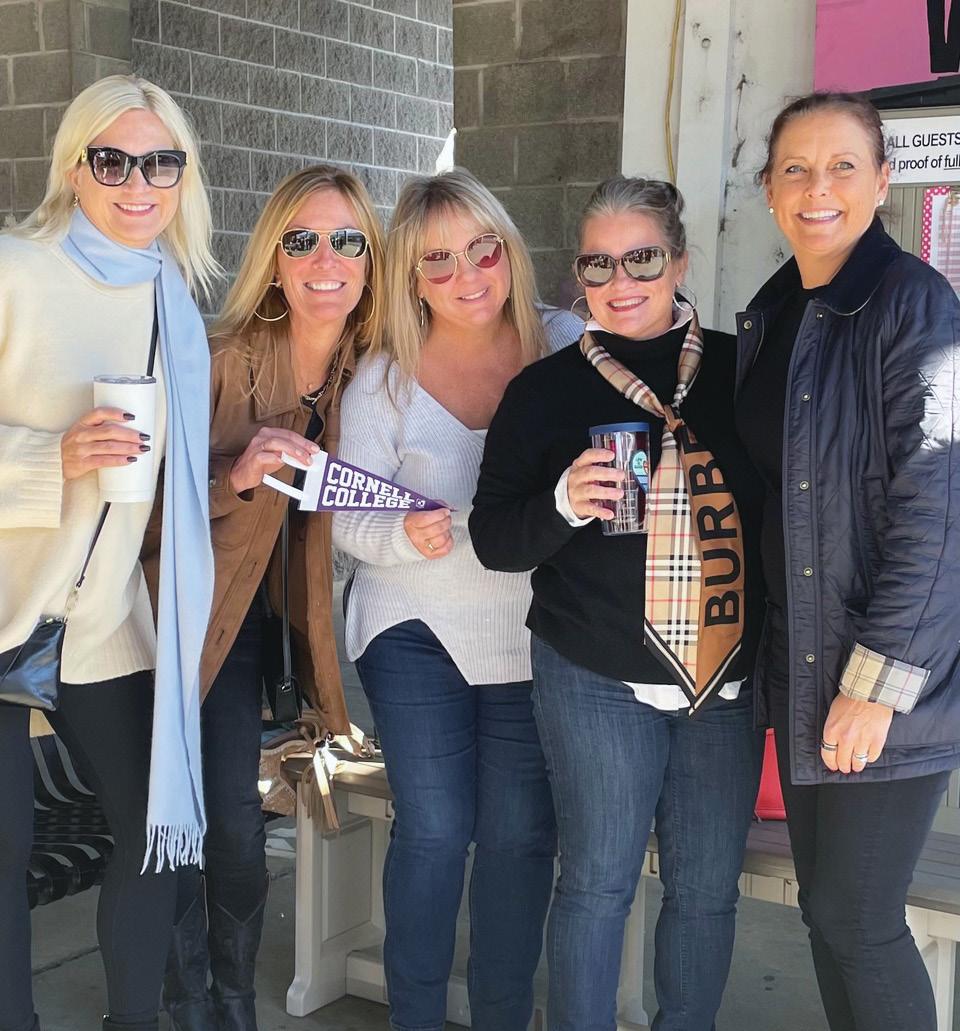
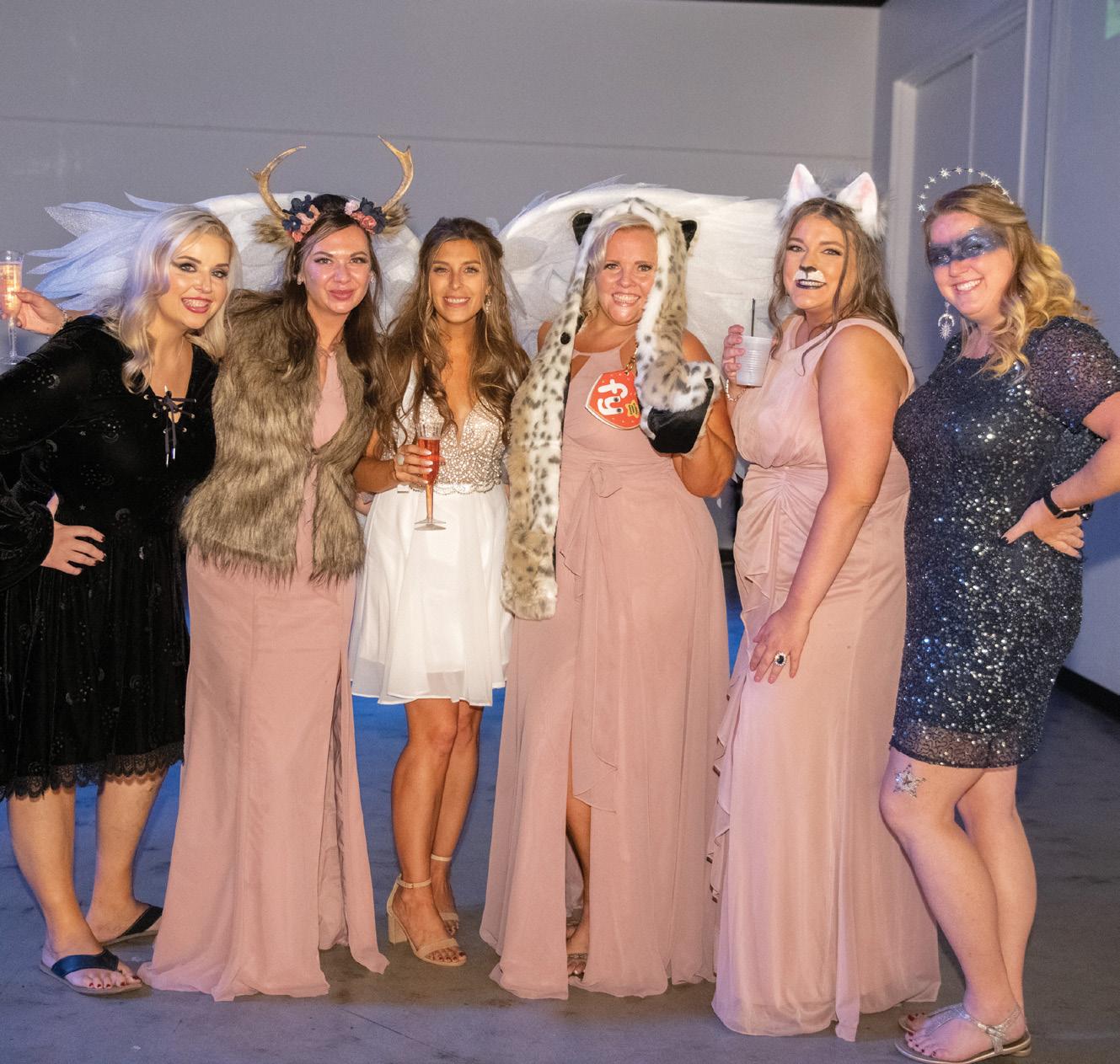
 Cassie Skenandore ’08, Ashley Dvorak ’07, Sasha Burnett Gantzer ’08, Allison Peters ’04, Samantha Stegman ’08, and Kaitlyn Wright ’10.
In November 2021 a group of Thetas gathered in Nashville at the home of Patty Helland ’86 for a fun reunion. From left: Leslie Grau Frady ’86, Karen Friedhoff Mertes ’87, Patty Helland ’86, Michelle Cook Yokaris ’86, and Ann Lewis Murray ’86.
Politics Professor Emeritus Craig Allin (left) and Dean Riesen ’79 met in Arizona, where Dean lives and Craig winters, to hike Picacho Peak.
Cassie Skenandore ’08, Ashley Dvorak ’07, Sasha Burnett Gantzer ’08, Allison Peters ’04, Samantha Stegman ’08, and Kaitlyn Wright ’10.
In November 2021 a group of Thetas gathered in Nashville at the home of Patty Helland ’86 for a fun reunion. From left: Leslie Grau Frady ’86, Karen Friedhoff Mertes ’87, Patty Helland ’86, Michelle Cook Yokaris ’86, and Ann Lewis Murray ’86.
Politics Professor Emeritus Craig Allin (left) and Dean Riesen ’79 met in Arizona, where Dean lives and Craig winters, to hike Picacho Peak.
49 CORNELL REPORT | SUMMER 2022
Something clicked when Tabitha Snyder Abels ’96 (right) began her work-study position with Gerry Decious (left) for the buildings and grounds department. Thirty years later they are still close, with Tabitha last visiting Gerry in Iowa
1980s
Jerry Hawhee ’80 lives quietly in the mostly Mennonite village of Cantril, Iowa, where one cannot buy alcohol, tobacco, or a lottery ticket. He reports he’s fine with the lottery, and he can get cigars and pipe tobacco online, but good Scotch is another matter, especially when stranded during a pandemic. Jerry was divorced after 17 years of marriage. At 50, he was rapidly developing cataracts and, without surgery, would be totally blind within a couple of years. Receiving new lens implants radically improved his vision, allowing him to see and do things he never could before. Jerry is a writer and editor. In 2020 he completed and published two new books: a fantasy novel (first in a series under one of his literary pseudonyms, J.M. Kind), and a collection of literary erotic short stories (under Terrance Aldon Shaw). A number of his short stories have been published in multiauthor anthologies and literary magazines. Under the Shaw name, in addition to novels and short-story collections, his 500-plus-page reference work, “The Erotic Writer’s Thesaurus,” is a consistent best-seller on Amazon.
Denny Schertz ’82, Hudson, Wisconsin, helped organize the 150th anniversary of the founding of the Milts at Homecoming 2021. They had a couple of kegs on Friday night in the basement of what was once called Joe’s, some brats and burgers (and a few beers) at the football game on Saturday, and a banquet that night. The Class of ’82 had as many, or more, old Milts back as any other class, including Ed Petkevis ’82, Dan Sheehan ’82, Eugene Kratochvil ’82, Mike Boock ’82, and Kevin McGinity ’82 Denny has his room reserved for the 1982 40th Class Reunion in October 2022.
As of December 2021 Aida Audeh ’85, South Pasadena, Florida, took the opportunity after 19 years to retire early from her position as professor, department chair, and division head at Hamline University in St. Paul, Minnesota. She and her husband moved to Florida and are loving beach life and year-round sunshine in the St. Petersburg area.
G. Paul Beaumaster ’85 and Susie Wedes Beaumaster ’87, Northfield, Minnesota, are looking forward to being empty nesters next year. They enjoyed meeting up with Terry Moore ’84, Lisa Jackson Moore ’85, and Phil Hastings ’84 in the fall. In October they vacationed in Greece with their daughter, Sidney. They’ve also made a few trips to visit son Jack Beaumaster ’20 in Laramie, Wyoming, where he is a law student. Paul started yoga using his daughter’s free fitness app, HAVVI.
Kate Bell ’85, Syracuse, New York, writes, “I am working full time as a chaplain in eldercare, which has been my goal for many years. My Cornell grad daughter, Margaret Houston ’18, got her master’s in library science this year. Working in healthcare in the pandemic takes up most of my life, and the rest I spend with my family. Please mask and get vaccinated.”
As a cafe manager at a middle school, Debra Sperr Grillot ’85, Olathe, Kansas, reports it was great seeing the kids back this year. In July 2021 her son and his wife renewed their vows and had their “big” wedding, postponed from 2020. Then, in October, their daughter Laura got married. In December Debra traveled to New Jersey to see her nephew, a Marine on leave from Okinawa, and the baptism of his daughter.
Cheryl McRoberts ’85, Clinton, Iowa, reports she is grateful that she retired from teaching in May 2020. “While my retirement has not been what I envisioned at all, I am so glad that I didn’t have to go to work as so many did with the extra fear of COVID,” she writes.

We want to welcome our newest (and cutest) Cornellians into the world! Email alumni@cornellcollege.edu with the full name and birthdate of your newest family member, and we will send your future Ram a Wee C Club packet. 50
“It has been a year of sleeping until I feel well-rested instead of sleep-deprived, walking outside seven miles a day in all weather, reading without the guilt of feeling like I should be doing schoolwork, and spending time with my parents and adult children, albeit via phone or six feet apart at times.”
Terry Murphy ’85 and Jan Lansing Murphy ’83, Louisville, Colorado, lost their home and everything in it in the Marshall Fire in a heartbreaking end to 2021. There is a Go Fund Me page to provide support as they figure out what comes next. (At gofundme.com search “Help the Murphys”).
Michelle Achey Platt ’85, Lisbon, Iowa, decided to start the downsizing process. She started Medicare (she was a non-traditional graduate) and is parceling off a small acreage with all the buildings, keeping the conservation land, and moving in with her 86-year-old mother for a bit. Her mother decided she really wants to die in her own farmhouse versus moving in with Michelle.
Ann Edwards Frakes ’86, Dallas, Texas, writes that “several of us gathered last summer for Demi Giannopulos ’87’s celebration of life. She died in June 2020 from breast cancer, and we couldn’t safely get together till July 2021. We had 1,000 stickers made that have been posted all over the world in her memory. She was an international flight attendant.”
Patty Helland ’86, Nashville, Tennessee, reports that her daughter Maggie will transfer from the University of Tennessee to Cornell this fall.
Elizabeth Wilson ’86, Marion, Iowa, also has a daughter going to Cornell. Kathryn WilsonMaher ’23 is majoring in computer science like her mom. She pledged Theta, rather than Phi-O like Elizabeth.
Anthony Vaver ’88, Westborough, Massachusetts, reports that the British online magazine New Politic published an article he wrote on convict transportation from Great Britain to America. His piece is part of their Project Empire series exploring “Britain’s colonial acts abroad and the people over whom the British empire ruled.”
Candace Taylor Woods ’89, Moline, Illinois, has worked at Brooks Law Firm since 2008. Her oldest son, Adrian, graduated in 2020 from Bradley University. Her youngest son, Hunter, attends Luther College.
1990s
John Heaton ’91, Madison, Wisconsin, was in Washington, D.C., in early December 2021 and spent time with Gram Parker ’93, whom he had not seen in about 30 years. Also that month while sitting poolside in a suburban Chicago hotel, he was approached by a stranger who wanted to know if the big purple “C” on his sweatshirt stood for Cornell College. The stranger turned out to be a Class of ’00 grad.
Shawna Mulay Suckow ’91, Burnsville, Minnesota, has written her fifth book, “The Roaring Twenties: Better Sales & Marketing in the Post-Pandemic Decade.” It can be found on Amazon.
Lance VanGundy ’91, Marshalltown, Iowa, has been working tirelessly in the Marshalltown Emergency Room and notes that COVID has made his work a daily struggle. This past fall he posted a video on Facebook that went viral. He says he is glad the popularity of the video died down but wants his classmates to know he remains a passionate advocate for the vaccine and, if anyone has questions, he is happy to be a resource. He has now published book two of his Rune Fire Cycle, “Runes of the Prime.”
Terry Murphy ’85 and Jan Lansing
Craig Wood ’91, Overland Park, Kansas, writes that the pandemic continues to be in the background for most of the work for the department where he works. He has helped at the vaccination site regularly to help check people in. He is also currently working, through a grant, with two school districts to prevent and reduce food waste.
Jennifer Meyers Providence
’93 lives in Tucson, Arizona, with Noah, her husband of 25 years. They have five kids. Hannah, 23, graduated from the University of Arizona with a degree in illustration and design. Teddy, 20, plans to complete his training in reconnective healing. The others are Ollie, 16, Max, 13, and Essie, 10. Ollie wants to work as an EMT. “Max is trying to survive 8th grade and Essie is planning on working as a geoscientist, a crime scene cleaner (is that a thing?), and a construction worker. Why not? I found my groove when I found Chinese medicine in 1994,” Jennifer writes. She has an acupuncture practice inside a CrossFit gym. She returned to distance running and completed a half marathon.
Tabitha Snyder Abels ’96, Pontiac, Illinois, has maintained a friendship with her facilities work-study supervisor, Gerry Decious, for 30 years. “While working we would talk and share our life experiences. Something just clicked. Gerry was a sounding board for me while I was away from home for the first time. She was always encouraging and full of wisdom,” Tabitha writes. Gerry came
to Tabitha’s wedding in 1999. Tabitha visited on a road trip in 2004. The letters continued. “After my divorce in 2016, Gerry and I became even closer. I went to Iowa a couple of times to see her in 2017 and 2019, but we have not been able to do that since the pandemic. I am hoping we can meet up this year once again,” Tabitha writes. “People in every department make Cornell a great place. There are so many stories about the impact a professor had on a student or the bond of classmates. There is more to the Cornell experience. It is about the community as a whole and how those experiences shape our lives. Cornell is special for that reason, and I am grateful for the people of Cornell who changed my life for the better.”
2000s WEDDING
Sasha Burnett ’08 to Theodore Gantzer, Oct. 31, 2020
BIRTHS & ADOPTIONS
Asher Ervin Eimers, Nov. 21, 2021, to Chad Eimers ’00 and Karla Tejada
Eloise Scott Latimer, Nov. 11, 2021, to Daniel Latimer ’06 and Stefanie Ahrens Latimer ’06
Emilia Rose Knorr, Sept. 9, 2021, to Kristin Krile Knorr ’07 and Michael Knorr
Murphy ’83, Louisville, Colorado, lost their home and everything in it in the Marshall Fire in a heartbreaking end to 2021. There is a Go Fund Me page to provide support as they figure out what comes next: at gofundme.com search
51 CORNELL REPORT | SUMMER 2022
“Help the Murphys.”
After the passing of Jason Dooley ’99 in October 2020, Arianne Hartlove Dooley ’00, Denver, Colorado, and her son have been making strides at finding a new normal. In 2021 they made it to California for multiple trips learning to surf, as well as to Kauai and Iceland (no surfing in Iceland). Next fall they will begin college visits.
Heidi Abel Steffen ’00, Marion, Iowa, represents TitanTV Inc. at the executive level in the broadcast industry and has become a leader on many industry-wide initiatives, including the NAB (National Association of Broadcasters) Show exhibitor advisory board and on the group of industry executives developing the EIDR (Entertainment Identifier Registry Association) content standard.
Derek Brooks ’03 and Kari Reynolds Brooks ’04, Des Moines, Iowa, have been navigating the past couple of years with a lot of home improvements, camping, “fancy Fridays,” and trying to stay sane. “Fancy Friday was a weekly thing where we’d put on some good music, get dressed up like we were going out, make some cocktails, and either cook or order good foods,” Derek writes. In 2021 they bought a tiny camper and have been getting out to explore—including a visit to the Hilltop while camping at the Pal. They both turned 40 and were able to sneak in some birthday parties with a
few of their favorite Cornellians between COVID surges.
Justine Stewart Burke ’03 and Michael Burke ’01, Northglenn, Colorado, are raising three boys, ages 5, 9, and 11. They spend a lot of their time camping in the summer and connecting with Cornell alumni. Justine has recently gone into private practice providing therapy to clients of all ages. After leaving her therapist job in education, she began working with Strock Medical Group, a group of psychiatric nurses serving over 5,000 patients in Colorado. Justine continues to be an avid member of Orangetheory Fitness, recently completing her 500th class, and ran the 10-mile race as a part of the Denver Colfax Marathon in 2021.
Paige Sindt Butler ’03 lives in Phoenix, Arizona, with her 3-year-old son, Bexley, and husband, Chris. She’s a professor at the Middlebury Institute of International Studies, working remotely this year and likely to make a career change that allows them to stay in Phoenix. “The pandemic has been incredibly challenging, and working full time while parenting with a toddler at home has been something that even the block plan didn’t prepare me for,” she writes.
Katie Lewis Compton ’03 and Joe Compton ’04, Parker, Colorado, have two kids—their oldest started kindergarten and gymnastics and their youngest started soccer and is learning ninjility. Katie made audit partner at her public accounting firm and has started travels around the U.S. to meet with other new public accounting partners. Joe is a senior engineer in mine design. Katie had the joy of spending her 40th birthday with Lisa Haas ’01 and Kelly Dodd ’00 in Oregon wine country.
Kim Tietjen Harden ’03 reports that Ian Harden ’03 is still enjoying being CEO of their family in Colorado Springs, Colorado. “He stays busy being chauffeur, coach, chef, etc., to our busy kids (ages 11, 10, and 6),” she writes. “He finds time to still be one of the best athletes around, playing golf, hockey, basketball, tennis, softball, and skiing whenever possible. He also still owns a brewery in Costa Rica!” Kim, an anesthesiologist, was elected chairman of her group and has been chief of anesthesia at Penrose-St. Francis since 2018. When she has free time, she tries to travel as much as possible and has been able to visit some really amazing places despite the pandemic. She golfs, skis, and plays softball with Ian. Red Kempf ’03, St. Paul, Minnesota, still enjoys living in a retirement community. After recovering from COVID in 2020, Red’s surgical journey was able to continue with two surgeries in 2021. “I’m enjoying photography and creating art and spending time with my two nieces. Looking forward to things reaching whatever normal will become when road trips can once again take place,” Red writes.
Sarah Ray Lawrence ’03 lives in Morehead City, North Carolina, with her husband and three children, Jonathan (6), Ava (4), and Owen (2). “I love my role as a stay-at-home mom, and I am passionate about maintaining a healthy lifestyle,” she writes.
Amber Gallegos Moore ’03, Charlotte, Michigan, and her family decided to make a change and moved to Michigan in July 2020. Her kids, Ryan (9) and Clara (4), are having fun exploring. Amber works in the public school system as an early childhood special educator. On their trek to Michigan, they visited Leah Hagedorn Arp ’03 and her family in Iowa. More recently, they met up with Leah Jacobs Sturm ’03 and her family at Pokagon State Park in Indiana. “It felt so good to reconnect,” Amber writes. “During these interesting times having human connection is good for the soul.”
Maggie Elliott Nelson ’03, Evergreen, Colorado, is a relationship therapist, working primarily with couples, but also with consensual non-monogamy and individuals who are working on strengthening relationships in their lives. She went to fulltime private practice just before the pandemic hit and has built a thriving virtual practice. She and Ian celebrated their third wedding anniversary and are planning an adventure to Asia or Australia, two continents Maggie hasn’t visited. They’re enjoying mountain life with their dogs, and Maggie is learning more about carpentry and repurposing furniture.
Amanda Prince ’03, Cambridge, Massachusetts, is a senior scientist at Vedanta Biosciences where they are taking a “bugs as drugs” approach to use bacteria as a therapeutic. Amanda is leading the efforts for the immunology team and working on drug development in infectious disease, autoimmunity, and oncology. She lives with her husband, their daughter Freya, and dog Bruno. Over the summer they traveled to Michigan to see Paige Sindt Butler ’03 and family. “It was healing to laugh and hug after time in quarantine,” she writes.
Jeff and Bekka Youngquist
Simmering ’03, Colorado Springs, Colorado, are working for a school district in the southern part of Colorado Springs. Their two daughters are in 5th and 7th grades and
Derek Brooks ’03 and Kari Reynolds
52 ALUMNI NEWS
Brooks ‘04 have been navigating the past couple of years with a lot of home improvements, camping, “fancy Fridays,” and trying to stay sane. “Fancy Friday was a weekly thing where we’d put on some good music, get dressed up like we were going out, make some cocktails, and either cook or order good foods,” Derek writes.
enjoy soccer and robotics. Last summer they participated in a church service trip and were able to support a group of people in Cleveland as they work to transform a community. They stopped in Iowa, drove through the Pal, and had lunch with Brian Manatt ’03 and family. “Other than that trip and seeing some family, we have spent the last two years completing lots of puzzles, baking at home, and learning how to teach through a computer,” she writes.
U.S. Rep. Cindy Axne chose Atlantic, Iowa, administrator John Lund ’07 as her Citizen of the Week early in 2022.
Sasha Burnett Gantzer ’08 of Aurora, Colorado, eloped with Theodore Gantzer on Oct. 31, 2020, in Telluride, Colorado, “just the two of us due to COVID,” she reports. “We followed that up with a Halloween-themed wedding in Tempe, Arizona, on Oct. 30, 2021.”
Elinor Levin ’09, Iowa City, Iowa, is running for the Iowa House of Representatives to serve newly created District 89 in Iowa City.
Kate Mendenhall Mosetick ’09, Visalia, California, took a new position as literacy intervention department lead and also oversees Title I programs at the alternative high school where she teaches. Her family also grew with the adoption of two brother huskies, Merry and Pippin.
2010s
BIRTHS & ADOPTIONS
Amara Winnifred London, March 13, 2022, to Adeara Jean Maurice London ’12 and Lucas London
Myles Charles Joseph Blatchford, July 17, 2020, to Angelica BlatchfordEngland ’16 and Ben Blatchford
Mateo Ignacio Martinez-Mason, March 21, 2022, to Sanjuanita “Sam” Martinez ’16 and Patrick Mason

Annie Hettinger ’11, Dillon, Colorado, is a skier with Atomic Skis and for a women’s active wear company (Kari Traa). In addition, she just started her BSN through Denver College of Nursing.
Kat Terrell Sung ’11, Fairfax, Iowa, was promoted to counseling supervisor at Foundation 2. Kat supervises crisis counselors who answer the crisis/suicide prevention line. Kat is changing her name from Kalli Terrell to Kat Willow Sung.
Ashleigh Kanack ’15, Colorado Springs, Colorado, is working as a psychiatric nurse at Peak View Behavioral Health.
Fiona Flynn ’16, Charlottesville, Virginia, started her dream job with the University of Virginia as the Morven Kitchen Garden Coordinator. It’s a studentled project in sustainable agriculture on a plot of land once owned by Thomas Jefferson. She’s responsible for the cultivation of fruits, mushrooms, and vegetables for sale to UVA’s dining service provider, as well as directly to the UVA community through a Community Supported Agriculture (CSA) subscription program. She reports that the student garden management position she held at Cornell’s student garden was excellent preparation for this position.
“We sold over 500 pounds of produce directly to Bon Appétit that summer,” she writes. “I am also grateful for my capstone experience in the Environmental Studies program, where I researched small farm CSA marketing and distribution practices.”
KateLynn Hohman ’18 lived in Thailand the last year and started a job teaching English, global perspectives, and health at Assumption Primary School in the business district of Bangkok.
Alumni know it is the people on the Hilltop who make a difference in the lives of students.

The qualities you appreciated in the faculty and staff you met are the same qualities we still seek when hiring today—critical thinking, kind and helpful, knowledgeable, and community-minded.
Check out our job listings for yourself and share them with those you think would be a great addition to the Cornell Ramily.
Cornell
our
Crnl.co/jobs Consider working on the Hilltop 53
College is committed to fostering a faculty and staff community that reflects our diverse student body. We encourage applications from candidates who share
vision for a welcoming campus community that embraces differing backgrounds, viewpoints, and identities.
In memoriam
Marcella Lee ’48
Marcella Adelaide Lee ’48, Cornell College professor emerita of music, died March 12, 2022, in Holland, Michigan, at the age of 96.
At Cornell she was one of the few women faculty members and department chairs of her era. She founded the Messiah Sing-Along, directing 20 of its subsequent performances that attracted hundreds of singers to King Chapel to participate in the annual production.


Lee earned her bachelor of music education degree from Cornell and a master’s in music from Syracuse University. Her career took her from teaching music in the public schools to teaching voice and music fundamentals at the University of Minnesota (1959–68) to her professorship at Cornell (1968–1991). While she was singing professionally, she was a lead in three operettas produced by the Guthrie Theater, she sang with a touring company of “Damn Yankees,” and was the soprano soloist in a Robert Shaw Chorale production of “The Messiah.” She directed numerous church choirs, which gave her the opportunity to do what she loved best: create a shared musical experience with others.
In retirement she moved to Holland, Michigan, and made the most of the local cultural offerings. She continued to write music and theater reviews and exhibit show dogs, first Westies, then Havanese. She was the Class Agent for the Cornell Class of 1948 and organized a successful 50th reunion class gift for the renovation of the King Chapel organ.
She is survived by her daughter, April, and two granddaughters.
Gilbert Davis ’64
Gilbert Davis ’64, who argued the landmark 1996 Clinton v. Jones case that subsequently led to President Clinton’s impeachment for his affair with Monica Lewinsky, died Feb. 13, 2022. He was 80.
After graduating from the University of Virginia School of Law in 1969, Davis was appointed Assistant U.S. Attorney for the Eastern District of Virginia. He prosecuted a panoply of federal crimes which included the first aircraft hijacking in America, the first case under the Clean Air Act, and the first case under the 1968 Gun Control Act.
Davis successfully tried cases in 20 states and the District of Columbia. In 1973 he started private practice in the law firm of Duvall, Tate, Bywater and Davis. He filed a case against Bethlehem Steel Corporation on behalf of a Kentucky mountaineer who claimed ownership of the coal under his land. The judgment was the largest unliquidated damage award in Kentucky history.
In the first lawsuit against a sitting U.S. president, Davis’s client, Paula Corbin Jones, sued President Clinton for unwanted sexual conduct. Clinton appealed to the U.S. Supreme Court that he was immune, but the Court ruled 9-0 that Clinton must submit to the litigation process.
Davis served on the Cornell College Alumni Board from 1978-82. He was a longtime member of the Fairfax County Republican Committee and held leadership roles for federal and state Republican candidates for public office.

He is survived by two daughters and seven grandchildren.
Ernest Buresh
Cornell Life Trustee and Iowa banker Ernest J. Buresh died April 24, 2022. He was 95.
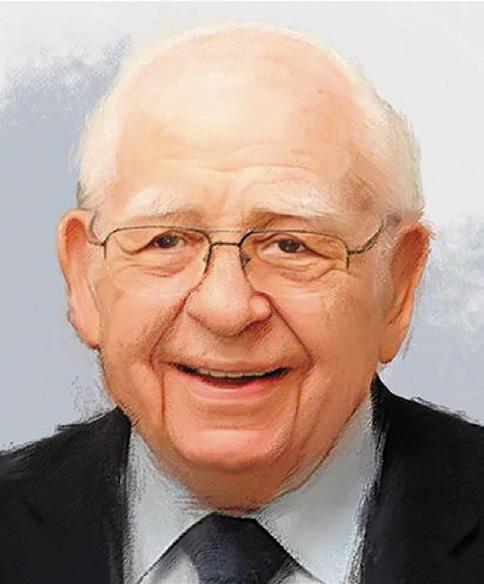
Buresh served in the U.S. Army during World War II, and held an agricultural engineering degree from Iowa State University, a J.D. from the University of Iowa, and a banking degree from the University of Wisconsin School of Banking. He married Joanne Paulsen Buresh ’51 in 1949.
After law school he worked in the trust department at Merchants National Bank in Cedar Rapids until purchasing the Martelle Savings Bank and Anamosa Savings Bank. The family, now including two daughters, moved to Anamosa in 1963, where they would reside until moving to Cedar Rapids in 1992. During their years in Anamosa, Buresh purchased banks in Onslow, Tipton, Springville, Shueyville, and Cedar Rapids, and finally bought and restored a historic downtown Cedar Rapids bank. He continued in banking until the flood of 2008.
He provided for a family that included a daughter with special needs, not only financially but by investing his time. There were family car vacations every summer, and later trips to Europe and then with the grandchildren to Australia, New Zealand, Hawaii, and Disney World.
Buresh served on the boards of Cornell College, the University of Iowa Foundation, and the Hall-Perrine Foundation, and was a life director at Cedar Rapids’ St. Luke’s Hospital. He was a generous philanthropist, especially to libraries, education, and health and human services institutions in the region.
He is survived by his wife of 72 years, Joanne, daughter Wendy Buresh ’74 and her husband Alan Robb, and two grandchildren.
CORNELL COLLEGE ARCHIVES
54
Neil Wylie
Neil Wylie, who taught psychology at Cornell College from 1966 to 1981, died June 16, 2021, in Hartford, Maine.
At Cornell he developed an origins of behavior interdisciplinary major and spent two January terms in Colorado with students exploring animal behavior and ecology. In 1971 Wylie and four students conducted a yearlong experiment with 12 mice of three different varieties caught near campus. The study was considered a ground-breaking test of the use of wild rodents whose heredity and behavior were uninfluenced by laboratory breeding and confinement. After they completed the experiment, the mice were released.

Wylie’s roles at Cornell included chairing the Psychology Department and serving as assistant dean of the college. In 1980-81 he was an American Council on Education Governmental Fellow with the Army Continuing Education System in Washington, D.C. At the end of that year Wylie resigned and moved to Michigan as vice president at the Great Lakes College Association, where he worked until 1989. He finished his career as the director of the Council of Presidents of New England Land Grant Universities. Upon retirement in 2002 he and his wife, Jane Wylie, enjoyed different areas of the country, moving from Durham, North Carolina, to Denver, Colorado, then Holland, Michigan, finally settling in Maine and as snowbirds in Arizona.
He is survived by his wife, Jane, who in 2022 established the Neil and Jane Wylie Endowed Scholarship Fund. Because the Wylies so enjoyed the Cornell experience provided to them and the students of the 1970s, the fund is designed to support similar opportunities for students of today and in the future.
Deaths
Luman Colton ’43, Cedar Rapids, Iowa, Jan. 20, 2022
Alice Loomis Guiher ’43, Minneapolis, Minnesota, Dec. 21, 2021
Mary Miller Christensen ’45, Murray, Kentucky, Jan. 14, 2022
Melvin Meggers ’45, Marion, Iowa, Jan. 30, 2022
Mary Ames Hykes ’47, Cedar Rapids, Iowa, Jan. 20, 2022
Helen Houg Sanborn ’48, Rochester, Minnesota, Dec. 27, 2021
Albert Boysen ’49, Tampa, Florida, Feb. 2, 2022
LaVone Chermak Luther ’49, Cedar Rapids, Iowa, Jan. 20, 2022
Joanne Whitbeck Smartt ’49, Cupertino, California, Dec. 24, 2021
William Walters ’51 , Marion, Iowa, Feb. 22, 2022
Lois Hinton Evans ’52 , Montezuma, Iowa, Jan. 26, 2022
Nina Northrup McGahan ’54 , Cedar City, Utah, Jan. 1, 2022
Burton Kirkman ’55, Willow Street, Pennsylvania, Feb. 2, 2022
Daniel Stapay ’57, Steamboat Springs, Colorado, Dec. 3, 2021
Shirley Dalziel Ludeking ’58, Decorah, Iowa, Sept. 30, 2021

Karl Tandy ’58, Windsor Heights, Iowa, Nov. 19, 2021
Joanne Meharry Cooper ’59, Urbandale, Iowa, Nov. 27, 2021
Joan Rossdeutcher Jacobs ’59, Santa Barbara, California, July 1, 2021
Robert Maly ’62 , Shaver Lake, California, Nov. 4, 2021
William Thorp Jr. ’62 , West Palm Beach, Florida, Oct. 21, 2021
Richard Swanson ’63, Bloomington, Minnesota, Aug. 25, 2020
Janet Danda Hopp ’64 , Arlington Heights, Illinois, Dec. 21, 2021
Patricia Errington Schnack ’64 , Iowa City, Iowa, Dec. 26, 2021
Sandy Geyer Youman ’65, Austin, Texas, Feb. 25, 2022
William Killerlain ’66, Palm Harbor, Florida, March 18, 2020
Thomas Reid ’67, Sachse, Texas, Dec. 18, 2021
Thomas Bullis ’72 , Maggie Valley, North Carolina, Feb. 13, 2022
Robert Schueler ’74 , Mount Vernon, Iowa, Jan. 19, 2022
Laura Bruce ’75, Omaha, Nebraska, Sept. 9, 2021
R. Jane Griesy ’75, Two Harbors, Minnesota, Dec. 1, 2021
Regan Ganoung Nichols ’82 , Midwest City, Oklahoma, Feb. 25, 2022
Paul Hedges ’83, Chesapeake, Virginia, Dec. 22, 2021
Richard Gray ’86, Tallahassee, Florida, Dec. 18, 2021
Beth Newton Poci ’99, Muscatine, Iowa, Feb. 19, 2022
Audrey Borenstein , sociology professor 1965–69, Southbury, Connecticut, Nov. 19, 2021
William Stoll, honorary alumnus, Columbus, Ohio, Dec. 9, 2021
Robert Witte, psychology professor 1957–61, Menlo Park, California, Feb. 19, 2022
55 CORNELL REPORT | SUMMER 2022
McLennan College Hall
holds our stories
By Jan Thomas ’80
Iwas inspired to contribute to the renovation of McLennan College Hall because it is the embodiment of the careers that have been built here, the classes that have been taught, the research conducted, the students whose lives have been transformed. This building holds our stories. It holds my stories.
I grew up in College Hall. I don’t mean it was just where I spent lots of time while I was a student at Cornell, although it was that. My relationship with this building spans most of my life. I am the daughter of Richard “The Rev” Thomas, whose office was in this building for most of his 30-year career.
In winter I would often stop by his office as I walked up and over Fifth Avenue on my way home from school. At the time, his office was in the basement next to the janitor’s closet. The door was always open (even if he wasn’t there) and the coffee urn always ready with hot water for tea, hot chocolate, or a cup of Nescafé.
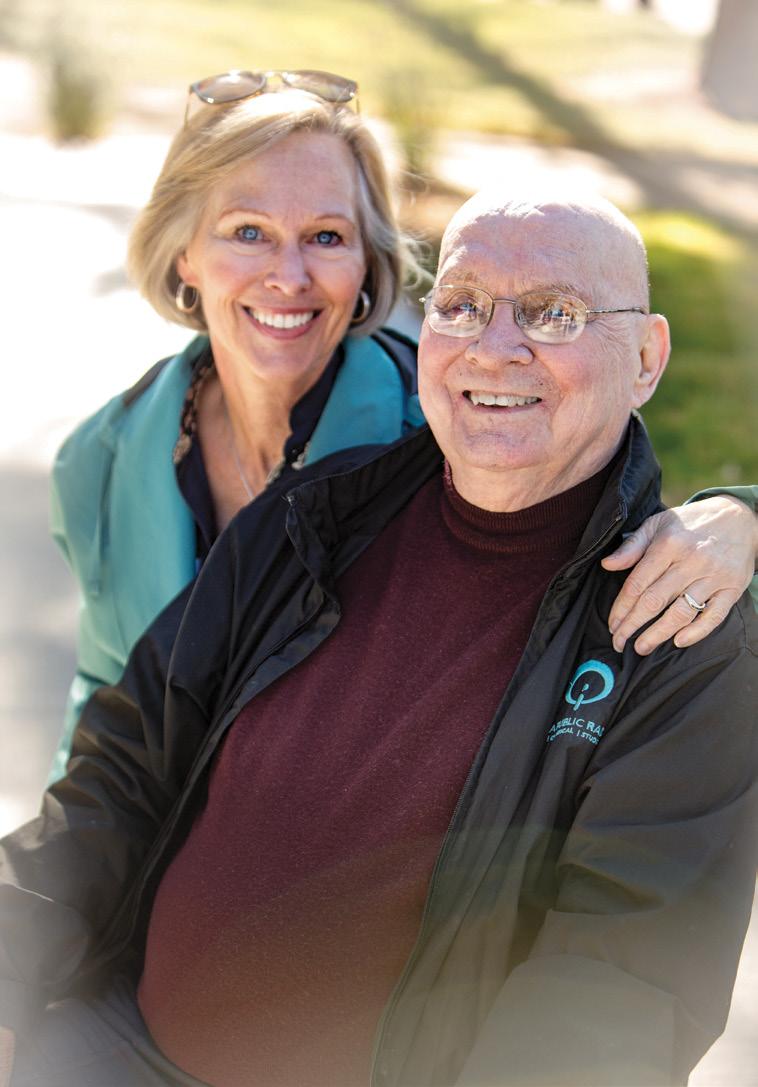
As I got older I typed my high school papers in his office. As a high school senior I took my first college class in this building, Intro to Sociology with Charlotte Vaughan. After the first test Charlotte called me into her office. I expected her to tell me it was a good first effort and give me suggestions for how I could do better next time. Instead, she told me that
I had one of the highest scores in the class and that I should consider taking more sociology—at Cornell, of course. It seemed she had my path already planned.
I will spare you the details of the next 15 years, my “exploration years,” but I did eventually graduate from Cornell, and I got a master’s degree in social work and a Ph.D. in sociology (as Charlotte instructed). And, later, with my 6-month-old son, Eric, in tow, I returned to teach a few blocks in the sociology department. In 2013 I sat outside on the lawn behind the building and watched Eric graduate from Cornell. And now I return as a Trustee, wanting to preserve this building so others can create stories here.
When you go inside this building, be mindful of not just how beautiful it looks but how it lives. Think of the people and relationships inside this building that make it uniquely Cornell in our memories. Let us recognize and remember all the students, the faculty, the staff who have inhabited this place and their role in creating our memories. We have all participated in “building” College Hall. Let us continue to preserve it, as McLennan College Hall, for those whose narratives are yet to be written.
Cornell Trustee Jan Thomas ’80 is senior advisor for community relations at Kenyon College in Gambier, Ohio.
Adapted from Thomas’ remarks at the Oct. 23, 2021, dedication of McLennan College Hall.
Jan Thomas ’80 and Emeritus Professor The Rev. Richard Thomas
7 56 LAST WORD
ROBYNSCHWAB AARON ‘0
Create your Legacy
“I want to give something to Cornell because it gave so much to me. I managed, through a Cornell education and just luck, to become an actor, to join the foreign service, and have a very satisfying career. You have to support an institution that helps you achieve those things.”
Craig Kuehl ’66
WEB EXTRA Read Craig Kuehl’s story at crnl.co/kuehl
For more information about planned giving or our Heritage Society (for those who include Cornell in their estate plans or life income gifts), visit plannedgiving.cornellcollege.edu or contact Director of Development A.J. Plummer, 319.895.4331 or aplummer@cornellcollege.edu
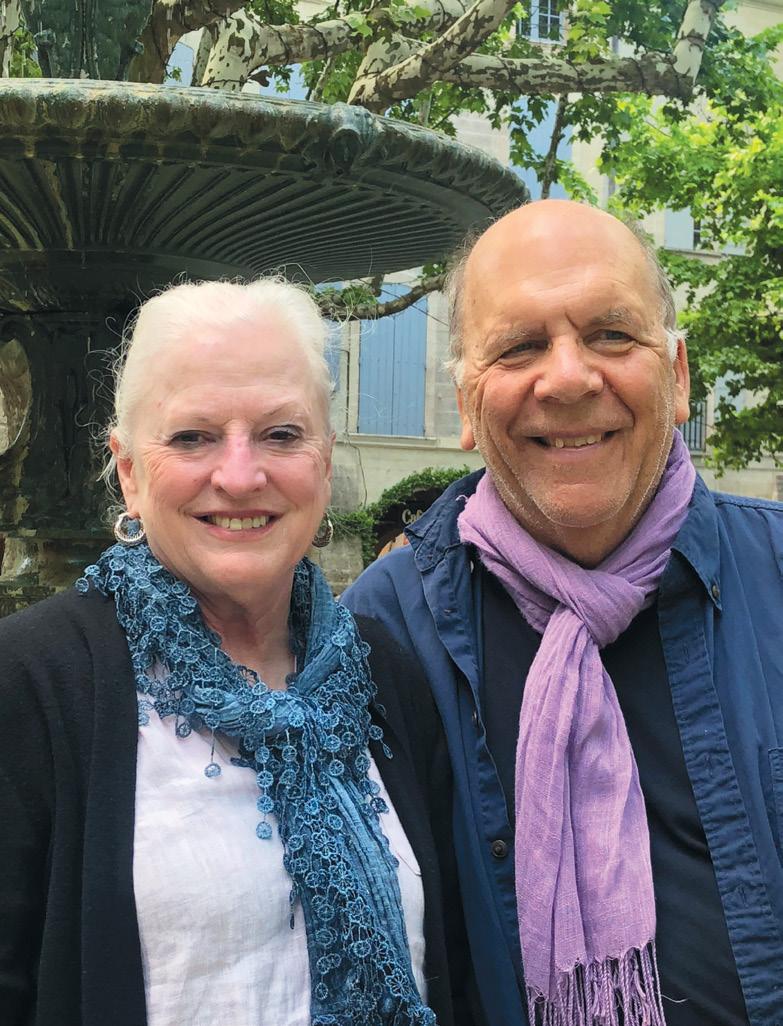
 Craig Kuehl ’66 with wife Jane E. Lucas
Craig Kuehl ’66 with wife Jane E. Lucas
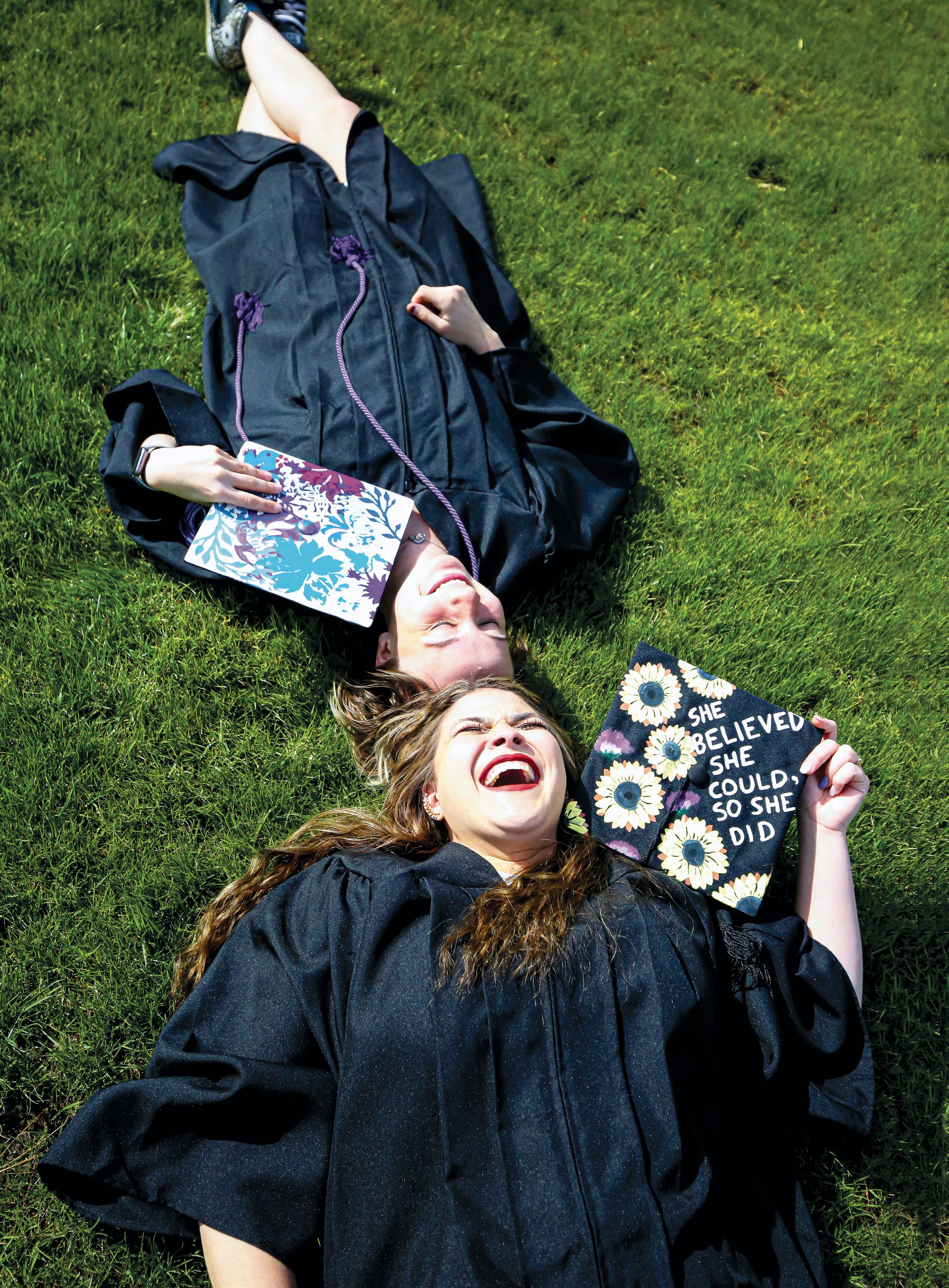
NON-PROFIT ORG. U.S. POSTAGE PAID CORNELL COLLEGE 600 FIRST STREET SW MOUNT VERNON, IA 52314–1098
Madeleine Althoff ’22
MEGAN AMR
(top) and Maria Thiele ’22 take a moment to celebrate their accomplishments before graduation in May.

 ON THE COVER: Foxden Press, named after the Van Etten-Lacey House’s nickname, prints cards, broadsides, chapbooks, artist’s books, and other materials using the Washington Letterpress with ink and metal type.
PHOTO BY MEGAN AMR
College Archivist Meghan Yamanishi keeps this hidden space’s items organized and preserved, including this turn of the century stereoscope.
ON THE COVER: Foxden Press, named after the Van Etten-Lacey House’s nickname, prints cards, broadsides, chapbooks, artist’s books, and other materials using the Washington Letterpress with ink and metal type.
PHOTO BY MEGAN AMR
College Archivist Meghan Yamanishi keeps this hidden space’s items organized and preserved, including this turn of the century stereoscope.
































































 Tom Adams ’63, Nancy Kleihauer Adams ’64, John McGrane ’73, and Marty Benson McGrane ’73
Tom Adams ’63, Nancy Kleihauer Adams ’64, John McGrane ’73, and Marty Benson McGrane ’73



 Cassie Skenandore ’08, Ashley Dvorak ’07, Sasha Burnett Gantzer ’08, Allison Peters ’04, Samantha Stegman ’08, and Kaitlyn Wright ’10.
In November 2021 a group of Thetas gathered in Nashville at the home of Patty Helland ’86 for a fun reunion. From left: Leslie Grau Frady ’86, Karen Friedhoff Mertes ’87, Patty Helland ’86, Michelle Cook Yokaris ’86, and Ann Lewis Murray ’86.
Politics Professor Emeritus Craig Allin (left) and Dean Riesen ’79 met in Arizona, where Dean lives and Craig winters, to hike Picacho Peak.
Cassie Skenandore ’08, Ashley Dvorak ’07, Sasha Burnett Gantzer ’08, Allison Peters ’04, Samantha Stegman ’08, and Kaitlyn Wright ’10.
In November 2021 a group of Thetas gathered in Nashville at the home of Patty Helland ’86 for a fun reunion. From left: Leslie Grau Frady ’86, Karen Friedhoff Mertes ’87, Patty Helland ’86, Michelle Cook Yokaris ’86, and Ann Lewis Murray ’86.
Politics Professor Emeritus Craig Allin (left) and Dean Riesen ’79 met in Arizona, where Dean lives and Craig winters, to hike Picacho Peak.











 Craig Kuehl ’66 with wife Jane E. Lucas
Craig Kuehl ’66 with wife Jane E. Lucas
